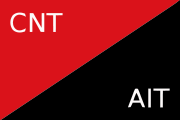Spanish Civil War
| ||||||||||||||||||||||||||||||
Part of a series on the |
|---|
| History of Spain |
.svg.png) |
| Timeline |
|
|
| Events leading to World War II | ||||||||||||||||||||||||||||||||
|---|---|---|---|---|---|---|---|---|---|---|---|---|---|---|---|---|---|---|---|---|---|---|---|---|---|---|---|---|---|---|---|---|
|
||||||||||||||||||||||||||||||||
The Spanish Civil War (Spanish: Guerra Civil Española),[nb 1] widely known in Spain simply as The Civil War (Spanish: Guerra Civil) or The War (Spanish: La Guerra), took place from 1936 to 1939 and was fought between the Republicans, who were loyal to the democratic, left-leaning Second Spanish Republic, and the Nationalists, a falangist group led by General Francisco Franco. Although often portrayed as a struggle between democracy and fascism, some historians consider it more accurately described as a struggle between leftist revolution and rightist counterrevolution.[6] Ultimately, the Nationalists won, and Franco then ruled Spain for the next 36 years, from April 1939 until his death in November 1975.
The war began after a pronunciamiento (declaration of opposition) by a group of generals of the Spanish Republican Armed Forces, originally under the leadership of José Sanjurjo, against the elected, leftist government of the Second Spanish Republic, at the time under the leadership of President Manuel Azaña. The Nationalist group was supported by a number of conservative groups, including the Spanish Confederation of Autonomous Right-wing Groups (Confederación Española de Derechas Autónomas, or CEDA), monarchists such as the religious conservative (Catholic) Carlists, and the Falange Española Tradicionalista y de las Juntas de Ofensiva Nacional Sindicalista, a fascist group.[nb 2][7] Sanjurjo was killed in an aircraft accident while attempting to return from exile in Portugal, whereupon Franco emerged as the leader of the Nationalists.
The coup was supported by military units in the Spanish protectorate in Morocco, Pamplona, Burgos, Zaragoza, Valladolid, Cádiz, Córdoba and Seville. However, rebelling units in some important cities—such as Madrid, Barcelona, Valencia, Bilbao and Málaga—were unable to capture their objectives, and those cities remained under the control of the government. Spain was thus left militarily and politically divided. The Nationalists and the Republican government fought for control of the country. The Nationalist forces received munitions and soldiers from Nazi Germany and Fascist Italy, while the communist Soviet Union and socialist Mexico offered support to the Republican (Loyalist) side. Other countries, such as the United Kingdom and France, operated an official policy of non-intervention.
The Nationalists advanced from their strongholds in the south and west, capturing most of Spain's northern coastline in 1937. They also besieged Madrid and the area to its south and west for much of the war. After large parts of Catalonia were captured in 1938 and 1939, the war ended with the victory of the Nationalists and the exile of thousands of leftist Spaniards, many of whom fled to refugee camps in southern France. Those associated with the losing Republicans were persecuted by the victorious Nationalists. With the establishment of a dictatorship led by General Franco in the aftermath of the war, all right-wing parties fused into the structure of the Franco regime.[7]
The war became notable for the passion and political division it inspired and for the many atrocities. Organized purges occurred in territory captured by Franco's forces to consolidate the future regime.[8] A significant number of killings took place in areas controlled by the Republicans.[9] The extent to which Republican authorities took part in killings in Republican territory varied.[10][11]
Background
The 19th century was a turbulent time for Spain. Those in favour of reforming Spain's government vied for political power with conservatives, who tried to prevent reforms from taking place. Some liberals, in a tradition that had started with the Spanish Constitution of 1812, sought to limit the power of the monarchy of Spain and to establish a liberal state. The reforms of 1812 did not last after King Ferdinand VII dissolved the Constitution and ended the Trienio Liberal government.[12] Twelve successful coups were carried out between 1814 and 1874.[12] Until the 1850s, the economy of Spain was primarily based on agriculture. There was little development of a bourgeois industrial or commercial class. The land-based oligarchy remained powerful; a small number of people held large estates called latifundia as well as all the important government positions.[13]
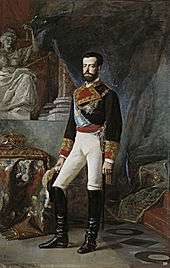
In 1868 popular uprisings led to the overthrow of Queen Isabella II of the House of Bourbon. Two distinct factors led to the uprisings: a series of urban riots and a liberal movement within the middle classes and the military (led by General Joan Prim) concerned with the ultra-conservatism of the monarchy. In 1873 Isabella's replacement, King Amadeo I of the House of Savoy, abdicated owing to increasing political pressure, and the short-lived First Spanish Republic was proclaimed.[14][15] After the restoration of the Bourbons in December 1874,[16] Carlists and Anarchists emerged in opposition to the monarchy.[17][18] Alejandro Lerroux, Spanish politician and leader of the Radical Republican Party, helped bring republicanism to the fore in Catalonia, where poverty was particularly acute.[19] Growing resentment of conscription and of the military culminated in the Tragic Week in Barcelona in 1909.[20]
Spain was neutral in World War I. Following the war, the working class, industrial class, and military united in hopes of removing the corrupt central government, but were unsuccessful.[21] Popular perception of communism as a major threat significantly increased during this period.[22] In 1923 a military coup brought Miguel Primo de Rivera to power; as a result, Spain transitioned to government by military dictatorship.[23] Support for the Rivera regime gradually faded, and he resigned in January 1930. He was replaced by General Dámaso Berenguer, who was in turn himself replaced by Admiral Juan Bautista Aznar-Cabañas; both men continued a policy of rule by decree. There was little support for the monarchy in the major cities; consequently, King Alfonso XIII gave in to popular pressure for the establishment of a republic in 1931 and called municipal elections for 12 April of that year. The socialist and liberal republicans won almost all the provincial capitals; following the resignation of Aznar's government, King Alfonso XIII fled the country.[24] At this time, the Second Spanish Republic was formed and would remain in power until the culmination of the Spanish Civil War.[25]
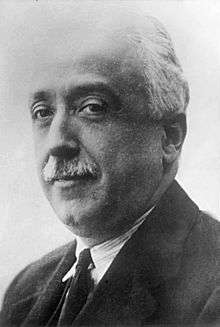
The revolutionary committee headed by Niceto Alcalá-Zamora became the provisional government, with Alcalá-Zamora as president and head of state.[26] The republic had broad support from all segments of society.[27] In May, an incident where a taxi driver was attacked outside a monarchist club sparked anti-clerical violence throughout Madrid and south-west Spain; the government's slow response disillusioned the right and reinforced their view that the Republic was determined to persecute the church. In June and July the Confederación Nacional del Trabajo (CNT) called several strikes, which led to a violent incident between CNT members and the Civil Guard and a brutal crackdown by the Civil Guard and the army against the CNT in Seville; this led many workers to believe the Spanish Second Republic was just as oppressive as the monarchy and the CNT announced their intention of overthrowing it via revolution.[28] Elections in June 1931 returned a large majority of Republicans and Socialists.[29] With the onset of the Great Depression, the government attempted to assist rural Spain by instituting an eight-hour day and giving land tenure to farm workers.[30][31]
Fascism remained a reactive threat, helped by controversial reforms to the military.[32] In December a new reformist, liberal, and democratic constitution was declared. It included strong provisions enforcing a broad secularization of the Catholic country, which many moderate committed Catholics opposed.[33] Republican Manuel Azaña became prime minister of a minority government in October 1931.[34][35] In 1933 the parties of the right won the general elections, largely owing to the anarchists' abstention from the vote,[36] increased right-wing resentment of the incumbent government caused by a controversial decree implementing land reform,[37] the Casas Viejas incident,[38] and the formation of a right-wing alliance, Spanish Confederation of Autonomous Right-wing Groups (CEDA); women's newfound right to vote also contributed to this (most women voted for centre-right parties).[39]
Events in the period following November 1933, called the "black two years", seemed to make a civil war more likely.[40] Alejandro Lerroux of the Radical Republican Party (RRP) formed a government; he reversed changes made under the previous administration[41] and also granted amnesty to the collaborators of the unsuccessful uprising by General José Sanjurjo in August 1932.[42][43] Some monarchists joined with the then fascist-nationalist Falange Española y de las JONS ("Falange") to help achieve their aims.[44] Open violence occurred in the streets of Spanish cities, and militancy continued to increase,[45] reflecting a movement towards radical upheaval, rather than peaceful democratic means as solutions.[46]
In the last months of 1934, two government collapses brought members of the CEDA into the government.[47][48] Farm workers' wages were cut in half, and the military was purged of Republican members.[48] A popular front alliance was organized,[48] which narrowly won the 1936 elections.[49] Azaña led a weak minority government, but soon replaced Zamora as president in April.[50] Prime Minister Santiago Casares Quiroga ignored warnings of a military conspiracy involving several generals, who decided that the government had to be replaced to prevent the dissolution of Spain.[51]
Military coup
Preparations

In an attempt to remove suspect generals from their posts, the Republican government sacked Franco as chief of staff and transferred him to command of the Canary Islands.[52] Manuel Goded Llopis was removed as inspector general and was made general of the Balearic Islands. Emilio Mola was moved from head of the Army of Africa to military commander of Pamplona in Navarre.[52] This, however, allowed Mola to direct the mainland uprising. General Jose Sanjurjo became the figurehead of the operation and helped reach an agreement with the Carlists.[52] Mola was chief planner and second in command.[53] José Antonio Primo de Rivera was put in prison in mid-March in order to restrict the Falange.[52] However, government actions were not as thorough as they might have been, and warnings by the Director of Security and other figures were not acted upon.[54]
On 12 June, Prime Minister Casares Quiroga met General Juan Yagüe, who managed to falsely convince Casares of his loyalty to the republic.[55] Mola began serious planning in the spring.[53] Franco was a key player because of his prestige as a former director of the military academy and as the man who suppressed the Asturian miners' strike of 1934.[53] He was well respected in the Army of Africa, the Spanish Republican Army's toughest military force.[56] He wrote a cryptic letter to Casares on 23 June, suggesting that the military was disloyal, but could be restrained if he were put in charge. Casares did nothing, failing to arrest or buy off Franco.[56] On 5 July, a 'Dragon Rapide' aircraft was used by the British Secret Intelligence Service to transport Franco from the Canary Islands to Spanish Morocco.[57] It arrived on 14 July.[58]
On 12 July 1936 members of the Falange murdered a police officer in Madrid, Lieutenant José Castillo of the Guardia de Asalto, who was a Socialist party member and who, among other activities, was giving military training to the UGT young. Castillo was leading the unit of Guardia de Asalto that violently suppressed the riots after the funeral of Guardia Civil Lieutenant Anastasio de los Reyes. Los Reyes was shot by anarchists during the 14 April military parade that commemorated the 5 years of the Republic.[58]
Fernando Condés, the leader of the Guardia de Asalto, was a close personal friend of Castillo. The next day, his squad had sought to arrest José María Gil-Robles y Quiñones, founder of CEDA, as a reprisal for Castillo's murder, but he was not at home, so they went to the house of José Calvo Sotelo, a leading Spanish monarchist and a prominent parliamentary conservative.[59] Luis Cuenca, a member of the arresting group and a socialist, summarily executed Calvo Sotelo by shooting him in the back of the neck.[59] Hugh Thomas concludes that Condés intended to arrest Sotelo and that Cuenca acted on his own initiative, although he acknowledges other sources that dispute this finding.[60]
Massive reprisals followed.[59] The killing of Sotelo with police involvement aroused suspicions and strong reactions among the government's opponents on the right.[61] Although the nationalist generals were already in the advanced stages of a planned uprising, the event provided a catalyst and a public justification for their coup.[59]
The socialists and communists, led by Indalecio Prieto, demanded that arms be distributed to the people before the military took over. The prime minister was hesitant.[59]
Beginning of the coup
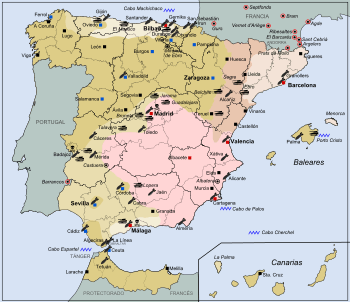
|
Initial Nationalist zone – Jul 1936
Nationalist advance to Sep 1936
Nationalist advance to Oct 1937
Nationalist advance to Nov 1938
Nationalist advance to Feb 1939
Last area under Republican control
|
|
The uprising's timing was fixed at 17 July, at 17:01, agreed to by the leader of the Carlists, Manuel Fal Conde.[62] However, the timing was changed—the men in the Spanish protectorate in Morocco were to rise up at 05:00 on 18 July and those in Spain proper a day later so that control of Spanish Morocco could be achieved and forces sent back to the Iberian Peninsula to coincide with the risings there.[63] The rising was intended to be a swift coup d'état, but the government retained control of most of the country.[64]
Control over Spanish Morocco was all but certain.[65] The plan was discovered in Morocco on 17 July, which prompted the conspirators to enact it immediately. Little resistance was encountered. In total, the rebels shot 189 people.[66] Goded and Franco immediately took control of the islands to which they were assigned.[53] On 18 July, Casares Quiroga refused an offer of help from the CNT and Unión General de Trabajadores (UGT), leading the groups to proclaim a general strike—in effect, mobilizing. They opened weapons caches, some buried since the 1934 risings.[65] The paramilitary security forces often waited to see the outcome of militia action before either joining or suppressing the rebellion. Quick action by either the rebels or anarchist militias was often enough to decide the fate of a town.[67] General Gonzalo Queipo de Llano managed to secure Seville for the rebels, arresting a number of other officers.[68]
Outcome
The rebels failed to take any major cities with the critical exception of Seville, which provided a landing point for Franco's African troops, and the primarily conservative and Catholic areas of Old Castile and León, which fell quickly.[64] Cádiz was taken for the rebels, with the help of the first troops from the Army of Africa.[69]
The government retained control of Málaga, Jaén, and Almería. In Madrid, the rebels were hemmed into the Montaña barracks, which fell with considerable bloodshed. Republican leader Casares Quiroga was replaced by José Giral, who ordered the distribution of weapons among the civilian population.[70] This facilitated the defeat of the army insurrection in the main industrial centres, including Madrid, Barcelona, and Valencia, but it allowed anarchists to take control of Barcelona along with large swathes of Aragón and Catalonia.[71] General Goded surrendered in Barcelona and was later condemned to death.[72] The Republican government ended up controlling almost all of the east coast and central area around Madrid, as well as most of Asturias, Cantabria and part of the Basque Country in the north.[73]
The rebels termed themselves Nacionales, normally translated "Nationalists", although the former implies "true Spaniards" rather than a nationalistic cause.[74] The result of the coup was a nationalist area of control containing 11 million of Spain's population of 25 million.[75] The Nationalists had secured the support of around half of Spain's territorial army, some 60,000 men, joined by the Army of Africa, made up of 35,000 men,[76] and a little under half of Spain's militaristic police forces, the Assault Guards, the Civil Guards, and the Carabineers.[77] Republicans controlled under half of the rifles and about a third of both machine guns and artillery pieces.[76][78]
The Spanish Republican Army had just 18 tanks of a sufficiently modern design, and the Nationalists took control of 10.[79] Naval capacity was uneven, with the Republicans retaining a numerical advantage, but with the Navy's top commanders and two of the most modern ships, heavy cruisers Canarias —captured at the Ferrol shipyard— and Baleares, in Nationalist hands.[80] The Spanish Republican Navy suffered from the same problems as the army—many officers had defected or had been killed after trying to do so.[79] Two-thirds of air capability was retained by the government – however, the whole of the Republican Air Force was very outdated.[81]
Combatants
The war was cast by Republican sympathizers as a struggle between tyranny and freedom, and by Nationalist supporters as communist and anarchist "red hordes" versus "Christian civilization".[82] Nationalists also claimed they were bringing security and direction to an ungoverned and lawless country.[82] Spanish politics, especially on the left, were quite fragmented, since socialists and communists supported the republic. During the republic, anarchists had mixed opinions, but major groups opposed the Nationalists during the Civil War. The Conservatives, in contrast, were united by their fervent opposition to the Republican government and presented a more unified front.[83]
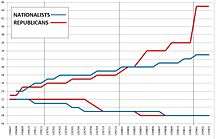
The coup divided the armed forces fairly evenly. One historical estimate suggests there were some 87,000 troops loyal to the government and some 77,000 joining the insurgency,[84] though some historians suggest that the Nationalist figure should be revised upwards and that it probably amounted to some 95,000.[85]
During the first few months both armies were joined in high numbers by volunteers; unfortunately, there are no scholarly estimates available. Starting August both sides launched own and similarly scaled conscription schemes, resulting in further massive growth of their armies. Finally, final months of 1936 recorded arrival of foreign troops, International Brigades joining the Republicans and Italian CTV, German Legion Condor and Portuguese Viriatos joining the Nationalists. The result was that in April 1937 there were some 360,000 soldiers in the Republican ranks and some 290,000 in the Nationalist ones.[86]
The armies kept growing. The principal source of manpower was conscription; both sides continued and expanded their schemes, the Nationalists drafting somewhat more aggressively, and there was little room left for volunteering. Foreigners hardly contributed to further growth; on the Nationalist side the Italians scaled down their engagement, while on the Republican side influx of new interbrigadistas hardly made up for losses, suffered by these units on the front. At the turn of 1937/1938 both armies achieved numerical parity and equalled about 700,000 each.[87]
Throughout 1938 the principal if not exclusive source of new men was draft; at this stage it was the Republicans who conscripted more aggressively. In mid-year, just prior to the Battle of Ebro, the Republicans achieved their all-time high commanding the army of slightly above 800,000 people; this was already no match for the Nationalists, who numbered 880,000.[88] The Battle of Ebro, fall of Catalonia and collapsing discipline produced massive shrinking of the Republican troops. In late February 1939 their army was 400,000[89] compared to more than double that number of Nationalists. In the moment of their final victory, the latter commanded over 900,000 troops.[90]
The total number of Spaniards serving in the Republican forces was officially stated as 917,000; latest scholarly work estimates the actual number as "well over 1 million men" (1.2m?),[91] though earlier historiographical studies claimed the Republican total (including foreigners) of 1.75m.[92] The total number of Spaniards serving in the Nationalist units is currently estimated at "nearly 1 million men",[91] though earlier works claimed (foreigners included) the total of 1.26m.[93]
Republicans
Only two countries openly and fully supported the Republic: Mexico and the USSR. From them, especially the USSR, the Republic received diplomatic support, volunteers, and the ability to purchase weapons. Other countries remained neutral, said neutrality being a great source of distress to the intelligentsia in the United States and United Kingdom, and to a lesser extent in other European countries and to Marxists worldwide. This distress led to the International Brigades, thousands of foreigners of all nationalities who voluntarily went to Spain to aid the Republic in the fight; they meant a great deal to morale but militarily were not very significant.
The Republic's supporters within Spain ranged from centrists who supported a moderately-capitalist liberal democracy to revolutionary anarchists who opposed the Republic but sided with it against the coup forces. Their base was primarily secular and urban but also included landless peasants and was particularly strong in industrial regions like Asturias, the Basque country, and Catalonia.[94]
This faction was called variously leales "Loyalists" by supporters, "Republicans", the "Popular Front", or "the government" by all parties; and/or los rojos "the Reds" by their opponents.[95] Republicans were supported by urban workers, agricultural labourers, and parts of the middle class.[96]
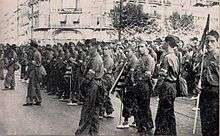
The conservative, strongly Catholic Basque country, along with Galicia and the more left-leaning Catalonia, sought autonomy or independence from the central government of Madrid. The Republican government allowed for the possibility of self-government for the two regions,[97] whose forces were gathered under the People's Republican Army (Ejército Popular Republicano, or EPR), which was reorganized into mixed brigades after October 1936.[98]
A few well-known people fought on the Republican side, such as English novelist George Orwell (who wrote Homage to Catalonia (1938), an account of his experiences in the war)[99] and Canadian thoracic surgeon Norman Bethune, who developed a mobile blood-transfusion service for front-line operations.[100] Simone Weil added herself for a while to the anarchist columns of Buenaventura Durruti, though fellow fighters feared she might inadvertently shoot them because she was shortsighted, and tried to avoid taking her on missions. By the account of her biographer Simone Petrement, Weil was evacuated from the front after a matter of weeks because of an injury sustained in a cooking accident.[101]
Nationalists

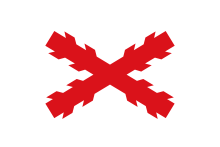
The Nacionales or Nationalists — also called "insurgents", "rebels", or, by opponents, Franquistas or "fascists" (see: the Nationalist faction) — feared national fragmentation and opposed the separatist movements. They were chiefly defined by their anti-communism, which galvanized diverse or opposed movements like falangists and monarchists. Their leaders had a generally wealthier, more conservative, monarchist, landowning background.[102]
The Nationalist side included the Carlists and Alfonsists, Spanish nationalists, the fascist Falange, and most conservatives and monarchist liberals. Virtually all Nationalist groups had strong Catholic convictions and supported the native Spanish clergy.[102] The Nationals included the majority of the Catholic clergy and practitioners (outside of the Basque region), important elements of the army, most large landowners, and many businessmen.[82]

One of the rightists' principal motives was to confront the anti-clericalism of the Republican regime and to defend the Catholic Church,[102] which had been targeted by opponents, including Republicans, who blamed the institution for the country's ills. The Church was against the Republicans' liberal principles, which were fortified by the Spanish Constitution of 1931.[103] Prior to the war, during the Asturian miners' strike of 1934, religious buildings were burnt and at least 100 clergy, religious civilians, and pro-Catholic police were killed by revolutionaries.[104][105]
Franco had brought in the mercenaries of Spain's colonial Army of Africa (Spanish: Ejército de África or Cuerpo de Ejército Marroquí) and reduced the miners to submission by heavy artillery attacks and bombing raids. The Spanish Legion committed atrocities—many men, women and children were killed, and the army carried out summary executions of leftists. The repression in the aftermath was brutal. In Asturias, prisoners were tortured.[106]
Articles 24 and 26 of the 1931 constitution had banned the Society of Jesus. This proscription deeply offended many within the conservative fold. The revolution in the Republican zone at the outset of the war, in which 7,000 clergy and thousands of lay people were killed, deepened Catholic support for the Nationalists.[107][108]
The Moroccan Fuerzas Regulares Indígenas joined the rebellion and played a significant role in the civil war.[109]
Other factions
Catalan and Basque nationalists were not univocal. Left-wing Catalan nationalists sided with the Republicans, while Conservative Catalan nationalists were far less vocal in supporting the government due to anti-clericalism and confiscations occurring in areas within its control. Basque nationalists, heralded by the conservative Basque Nationalist Party, were mildly supportive of the Republican government, although some in Navarre sided with the uprising for the same reasons influencing conservative Catalans. Notwithstanding religious matters, Basque nationalists, who were for the most part Catholic, generally sided with the Republicans, although the PNV, Basque nationalist party, was reported passing the plans of Bilbao defenses to the nationalists, in an attempt to reduce the duration and casualties of siege.[110]
Foreign involvement
The Spanish Civil War exposed political divisions across Europe. The right and the Catholics supported the Nationalists as a way to stop the expansion of Bolshevism. On the left, including labor unions, students and intellectuals, the war represented a necessary battle to stop the spread of fascism. Antiwar and pacifist sentiment was strong in many countries, leading to warnings that the Civil War had the potential of escalating into a second world war.[111] In this respect, the war was an indicator of the growing instability across Europe.[112]
The Spanish Civil War involved large numbers of non-Spanish citizens who participated in combat and advisory positions. Britain and France led a political alliance of 27 nations that promised non-intervention in the Spanish Civil War, including an embargo on all arms to Spain. The United States unofficially went along. Germany, Italy and the Soviet Union signed on officially, but ignored the embargo. The attempted suppression of imported materials was largely ineffective, however, and France especially was accused of allowing large shipments to Republican troops.[113] The clandestine actions of the various European powers were, at the time, considered to be risking another world war, alarming antiwar elements across the world.[114]
The League of Nations' reaction to the war was influenced by a fear of communism,[115] and insufficient to contain the massive importation by fighting factions of arms and other war resources. Although a Non-Intervention Committee was formed, its policies accomplished little and its directives were ineffective.[116]
Support for the Nationalists
Germany
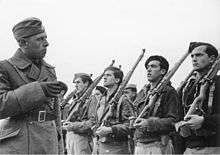
German involvement began days after fighting broke out in July 1936. Adolf Hitler quickly sent in powerful air and armored units to assist the Nationalists. The war provided combat experience with the latest technology for the German military. However, the intervention also posed the risk of escalating into a world war for which Hitler was not ready. He therefore limited his aid, and instead encouraged Benito Mussolini to send in large Italian units.[117]
Nazi Germany's actions included the formation of the multitasking Condor Legion, a unit composed of volunteers from the Luftwaffe and the German Army (Heer) from July 1936 to March 1939. The Condor Legion proved to be especially useful in the 1936 Battle of the Toledo. German efforts to move the Army of Africa to mainland Spain proved successful in the war's early stages.[118] German operations slowly expanded to include strike targets, most notably – and controversially – the bombing of Guernica which, on 26 April 1937, killed 200 to 300 civilians.[119] Germany also used the war to test out new weapons, such as the Luftwaffe Stukas, hold secret to the nationalists, and Junkers Ju-52 transport Trimotors used also as Bombers, which showed themselves to be effective.[120]
German involvement was further manifested through undertakings such as Operation Ursula, a U-boat undertaking, and contributions from the Kriegsmarine. The Legion spearheaded many Nationalist victories, particularly in aerial combat,[121] while Spain further provided a proving ground for German tank tactics. The training German units provided to Nationalist forces would prove valuable. By the War's end, perhaps 56,000 Nationalist soldiers, encompassing infantry, artillery, aerial and naval forces, had been trained by German detachments.[118]
A total of approximately 16,000 German citizens fought in the war, including approximately 300 killed,[122] though no more than 10,000 participated at any one time. German aid to the Nationalists amounted to approximately £43,000,000 ($215,000,000) in 1939 prices,[122][nb 3] 15.5 percent of which was used for salaries and expenses and 21.9 percent for direct delivery of supplies to Spain, while 62.6 percent was expended on the Condor Legion.[122] In total, Germany provided the Nationalists with 600 planes and 200 tanks.[123]
Italy
After Francisco Franco's request and encouragement by Hitler, Benito Mussolini joined the war. While the conquest of Ethiopia in the Second Italo-Ethiopian War made Italy confident in its power, a Spanish ally would nonetheless help secure Italian control of the Mediterranean Theater of Operations.[124] The Royal Italian Navy (Italian: 'Regia Marina) played a substantial role in the Mediterranean blockade, and ultimately Italy supplied machine guns, artillery, aircraft, tankettes, the Aviazione Legionaria, and the Corpo Truppe Volontarie (CTV) to the Nationalist cause.[125] The Italian CTV would, at its peak, supply the Nationalists with 50,000 men.[125] Italian warships took part in breaking the Republican navy's blockade of Nationalist-held Spanish Morocco and took part in naval bombardment of Republican-held Málaga, Valencia, and Barcelona.[126] In total, Italy provided the Nationalists with 660 planes, 150 tanks, 800 artillery pieces, 10,000 machine guns, and 240,000 rifles.[127]
Portugal
The Estado Novo regime of Portuguese Prime Minister António de Oliveira Salazar played an important role in supplying Franco's forces with ammunition and logistical help.[128] Despite its discreet direct military involvement – restrained to a somewhat "semi-official" endorsement, by its authoritarian regime, of a volunteer force of up to 20,000,[129][130] so-called "Viriatos" – for the whole duration of the conflict, Portugal was instrumental in providing the Nationalists with organizational skills and reassurance from the Iberian neighbour to Franco and his allies that no interference would hinder the supply traffic directed to the Nationalist cause.[131]
Others
The Conservative government of the UK maintained a position of strong neutrality and was supported by elites and the mainstream media, while the far left mobilized aid to the Republic.[132] The government refused to allow arms shipments and sent warships to try to stop shipments. It became a crime to volunteer to fight in Spain, but about 4,000 went anyway. Intellectuals strongly favoured the Republicans. Many visited Spain, hoping to find authentic anti-fascism. They had little impact on the government, and could not shake the strong public mood for peace.[133] The Labour Party was split, with its Catholic element favouring the Nationalists. It officially endorsed the boycott and expelled a faction that demanded support for the Republican cause; but it finally voiced some support to Loyalists.[134]
Romanian volunteers were led by Ion Moța, deputy-leader of the Iron Guard ("Legion of the Archangel Michael"), whose group of Seven Legionaries visited Spain in December 1936 to ally their movement with the Nationalists.[135]
Despite the Irish government's prohibition against participating in the war, around 600 Irishmen, followers of Irish political activist and Irish Republican Army leader Eoin O'Duffy, known as the "Irish Brigade", went to Spain to fight alongside Franco.[129] The majority of the volunteers were Catholics, and according to O'Duffy had volunteered to help the Nationalists fight against communism.[136][137]
Support for the Republicans
International Brigades

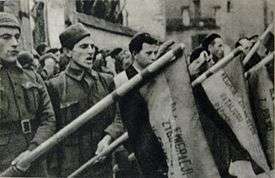
Many non-Spaniards, often affiliated with radical communist or socialist entities, joined the International Brigades, believing that the Spanish Republic was a front line in the war against fascism. The units represented the largest foreign contingent of those fighting for the Republicans. Roughly 40,000 foreign nationals fought with the Brigades, though no more than 18,000 were entered into the conflict at any given time. They claimed to represent 53 nations.[138]
Significant numbers of volunteers originated in the French Third Republic (10,000), Nazi Germany, the Federal State of Austria (5,000) and the Kingdom of Italy (3,350). More than 1000 each came from the Soviet Union, the United States, the United Kingdom, the Second Polish Republic, the Kingdom of Yugoslavia, the Kingdom of Hungary, and Canada.[138] The Thälmann Battalion, a group of Germans, and the Garibaldi Battalion, a group of Italians, distinguished their units during the Siege of Madrid. Americans fought in units such as the XV International Brigade ("Abraham Lincoln Brigade"), while Canadians joined the Mackenzie–Papineau Battalion.[139]
Over 500 Romanians fought on the Republican side, including Romanian Communist Party members Petre Borilă and Valter Roman.[140] About 145 men[141] from Ireland formed the Connolly Column, which was immortalized by Irish folk singer Christy Moore in the song "Viva la Quinta Brigada". Some Chinese joined the Brigades, and the majority of them eventually returned to China, while some went to prison or French refugee camps, and a handful remained in Spain.[142]
Soviet Union
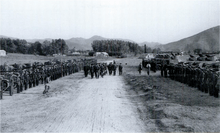
Though General Secretary Joseph Stalin had signed the Non-Intervention Agreement, the Soviet Union contravened the League of Nations embargo by providing material assistance to the Republican forces, becoming their only source of major weapons. Unlike Hitler and Mussolini, Stalin tried to do this covertly.[143] In total, estimates of material provided by the USSR to the Republicans vary between 634 and 806 planes, 331 and 362 tanks, and 1,034 and 1,895 artillery pieces.[144]
Stalin also created Section X of the Soviet Union military to head the weapons shipment operation, called Operation X. Despite Stalin's interest in aiding the Republicans, the quality of arms was inconsistent.[145][146] On one hand, many of the rifles and field guns provided were old, obsolete or otherwise of limited use (some dated back to the 1860s). On the other hand, the T-26 and BT-5 tanks were modern and effective in combat.[145] The Soviet Union supplied aircraft that were in current service with their own forces, but the aircraft provided by Germany to the Nationalists proved superior by the end of the war.[146]
The process of shipping arms from Russia to Spain was extremely slow. Many shipments were lost or arrived only partially matching what had been authorized.[147] Stalin ordered shipbuilders to include false decks in the original designs of ships and, while at sea, Soviet captains employed deceptive flags and paint schemes to evade detection by the Nationalists.[148]
The Republic paid for Soviet arms with official Bank of Spain gold reserves. This would later be the frequent subject of Franquist propaganda, under the term "Moscow Gold". The cost of the Soviet Union arms was more than the value of Spain's gold reserves, the fourth-largest in the world, estimated at US $500 million (1936 prices), 176 tonnes of which was transferred through France.[149]
The USSR sent a number of military advisers to Spain (2,000[150]–3,000[151]),[152] and, while Soviet troops were fewer than 500 men at a time, Soviet volunteers often operated Soviet-made tanks and aircraft, particularly at the beginning of the war.[138] In addition, the Soviet Union directed Communist parties around the world to organize and recruit the International Brigades.[153]
Another significant Soviet involvement was the activity of the People's Commissariat for Internal Affairs (NKVD) inside the Republican rearguard. Communist figures including Vittorio Vidali ("Comandante Contreras"), Iosif Grigulevich, Mikhail Koltsov and, most prominently, Aleksandr Mikhailovich Orlov led operations that included the murders of Catalan anti-stalinist Communist politician Andreu Nin[154] and independent left-wing activist José Robles.[155] Also, the shooting down in December 1936 of the French aircraft in which the delegate of the International Committee of the Red Cross (ICRC), Georges Henny, carried to France extensive documentation on the Paracuellos massacres was a NKVD-led operation.[156]
Mexico
Unlike the United States and major Latin American governments, such as the ABC nations and Peru, Mexico supported the Republicans.[157][158] Mexico refused to follow the French-British non-intervention proposals,[157] furnishing $2,000,000 in aid and material assistance, which included 20,000 rifles and 20 million cartridges.[157]
Mexico's most important contributions to the Spanish Republic was its diplomatic help, as well as the sanctuary the nation arranged for Republican refugees, including Spanish intellectuals and orphaned children from Republican families. Some 50,000 took refuge, primarily in Mexico City and Morelia, accompanied by $300 million in various treasures still owned by the Left.[159]
France
Fearing it might spark a civil war inside France, the leftist "Popular Front" government in France did not send direct support to the Republicans. French Prime Minister Léon Blum was sympathetic to the republic,[160] fearing that the success of Nationalist forces in Spain would result in the creation of an ally state of Nazi Germany and Fascist Italy, an alliance that would nearly encircle France.[160] Right-wing politicians opposed any aid and attacked the Blum government.[161] In July 1936, British officials convinced Blum not to send arms to the Republicans and, on 27 July, the French government declared that it would not send military aid, technology or forces to assist the Republican forces.[162] However, Blum made clear that France reserved the right to provide aid should it wish to the Republic: "We could have delivered arms to the Spanish Government [Republicans], a legitimate government... We have not done so, in order not to give an excuse to those who would be tempted to send arms to the rebels [Nationalists]."[163]
On 1 August 1936 a pro-Republican rally of 20,000 people confronted Blum, demanding that he send aircraft to the Republicans, at the same time as right-wing politicians attacked Blum for supporting the Republic and being responsible for provoking Italian intervention on the side of Franco.[163] Germany informed the French ambassador in Berlin that Germany would hold France responsible if it supported "the manoeuvres of Moscow" by supporting the Republicans.[164] On 21 August 1936, France signed the Non-Intervention Agreement.[164] However, the Blum government provided aircraft to the Republicans through covert means with Potez 540 bomber aircraft (nicknamed the "Flying Coffin") by Spanish Republican pilots),[165] Dewoitine aircraft, and Loire 46 fighter aircraft being sent from 7 August 1936 to December of that year to Republican forces.[166] The French also sent pilots and engineers to the Republicans.[167] Also, until 8 September 1936, aircraft could freely pass from France into Spain if they were bought in other countries.[168]
French novelist André Malraux was a strong supporter of the republican cause; he tried to organise a volunteer air force (Escadrile Espana) on the republican side but as a practical organiser and squadron leader he was somewhat idealistic and inefficient. The Regular Spanish Air force commander Andres Garcia La Calle was openly critical of Malraux's military efficiency but recognized his usefulness as a propagandist. His novel L'Espoir and the film version he produced and directed (Espoir: Sierra de Teruel) were a great help for the Republican cause in France.
Even after covert support by France to the Republicans ended in December 1936, the possibility of French intervention against the Nationalists remained a serious possibility throughout the war. German intelligence reported to Franco and the Nationalists that the French military was engaging in open discussions about intervention in the war through French military intervention in Catalonia and the Balearic Islands.[169] In 1938 Franco feared an immediate French intervention against a potential Nationalist victory in Spain through French occupation of Catalonia, the Balearic Islands, and Spanish Morocco.[170]
Besides the generally Republican-oriented sympathies and support in France, some right-wing extremists sided with Franco, most notably the members of La Cagoule who were instrumental in sabotaging ships transporting guns and civil relief equipment to Republican Spain in French ports.
Course of the war
1936

A large air and sealift of Nationalist troops in Spanish Morocco was organized to the southwest of Spain.[171] Coup leader Sanjurjo was killed in a plane crash on 20 July,[172][173] leaving an effective command split between Mola in the North and Franco in the South.[53] This period also saw the worst actions of the so-called "Red" and "White Terrors" in Spain.[174][175] On 21 July, the fifth day of the rebellion, the Nationalists captured the central Spanish naval base, located in Ferrol, Galicia.[176]
A rebel force under Colonel Alfonso Beorlegui Canet, sent by General Mola and Colonel Esteban García, undertook the Campaign of Gipuzkoa from July to September. The capture of Gipuzkoa isolated the Republican provinces in the north. On 5 September, the Nationalists closed the French border to the Republicans in the battle of Irún.[177] On 15 September San Sebastián, home to a divided Republican force of anarchists and Basque nationalists, was taken by Nationalist soldiers.[131] The Nationalists then advanced toward their capital, Bilbao, but were halted by Republican militias on the border of Biscay at the end of September.
The Republic proved ineffective militarily, relying on disorganized revolutionary militia. The Republican government under Giral resigned on 4 September, unable to cope with the situation, and was replaced by a mostly Socialist organization under Francisco Largo Caballero.[178] The new leadership began to unify central command in the republican zone.[179]
On the Nationalist side, Franco was chosen as chief military commander at a meeting of ranking generals at Salamanca on 21 September, now called by the title Generalísimo.[53][180] Franco won another victory on 27 September when his troops relieved the siege of the Alcázar in Toledo,[180] which had been held by a Nationalist garrison under Colonel José Moscardó Ituarte since the beginning of the rebellion, resisting thousands of Republican troops, who completely surrounded the isolated building. Moroccans and elements of the Spanish Legion came to the rescue.[181] Two days after relieving the siege, Franco proclaimed himself Caudillo ("chieftain", the Spanish equivalent of the Italian Duce and the German Führer -meaning: 'director') while forcibly unifying the various and diverse falangist, Royalist and other elements within the Nationalist cause.[178] The diversion to Toledo gave Madrid time to prepare a defense, but was hailed as a major propaganda victory and personal success for Franco.[182] On October 1, 1936 General Franco was confirmed head of state and armies in Burgos. A similar dramatic success for the Nationalists occurred on 17 October, when troops coming from Galicia relieved the besieged town of Oviedo, in Northern Spain.[183][184]
In October, the Francoist troops launched a major offensive toward Madrid,[185] reaching it in early November and launching a major assault on the city on 8 November.[186] The Republican government was forced to shift from Madrid to Valencia, outside the combat zone, on 6 November.[187] However, the Nationalists' attack on the capital was repulsed in fierce fighting between 8 and 23 November. A contributory factor in the successful Republican defense was the effectiveness of the Fifth Regiment[188] and later the arrival of the International Brigades, though only an approximate 3,000 foreign volunteers participated in the battle.[189] Having failed to take the capital, Franco bombarded it from the air and, in the following two years, mounted several offensives to try to encircle Madrid, beginning the three-year Siege of Madrid. The Second Battle of the Corunna Road, a Nationalist offensive to the northwest, pushed Republican forces back, but failed to isolate Madrid. The battle lasted into January.[190]
1937

With his ranks swelled by Italian troops and Spanish colonial soldiers from Morocco, Franco made another attempt to capture Madrid in January and February 1937, but was again unsuccessful. The Battle of Málaga started in mid-January, and this Nationalist offensive in Spain's southeast would turn into a disaster for the Republicans, who were poorly organised and armed. The city was taken by Franco on 8 February.[191] The consolidation of various militias into the Republican Army had started in December 1936.[192] The main Nationalist advance to cross the Jarama and cut the supply to Madrid by the Valencia road, termed the Battle of Jarama, led to heavy casualties (6,000–20,000) on both sides. The operation's main objective was not met, though Nationalists gained a modest amount of territory.[193]
A similar Nationalist offensive, the Battle of Guadalajara, was a more significant defeat for Franco and his armies. It proved the only publicised Republican victory of the war. Italian troops and blitzkrieg tactics were used by Franco, and while many strategists blamed the latter for the rightists' defeat, the Germans believed it was the former at fault for the Nationalists' 5,000 casualties and loss of valuable equipment.[194] The German strategists successfully argued that the Nationalists needed to concentrate on vulnerable areas first.[195]

The "War in the North" began in mid-March,[196] with the Biscay Campaign.[197] The Basques suffered most from the lack of a suitable air force.[198] On 26 April, the Condor Legion bombed the town of Guernica, killing 200–300 and causing significant damage. The destruction had a significant effect on international opinion.[199] The Basques retreated.[200]
April and May saw the May Days, infighting among Republican groups in Catalonia. The dispute was between an ultimately victorious government –Communist forces and the anarchist CNT. The disturbance pleased Nationalist command, but little was done to exploit Republican divisions.[201] After the fall of Guernica, the Republican government began to fight back with increasing effectiveness. In July, it made a move to recapture Segovia, forcing Franco to delay his advance on the Bilbao front, but for only two weeks. A similar Republican attack, the Huesca Offensive, failed similarly.[202]
Mola, Franco's second-in-command, was killed on 3 June, in an airplane accident.[203] In early July, despite the earlier loss at the Battle of Bilbao, the government launched a strong counter-offensive to the west of Madrid, focusing on Brunete. The Battle of Brunete, however, was a significant defeat for the Republic, which lost many of its most accomplished troops. The offensive led to an advance of 50 square kilometres (19 sq mi), and left 25,000 Republican casualties.[204]
A Republican offensive against Zaragoza was also a failure. Despite having land and aerial advantages, the Battle of Belchite, a place lacking any military interest, resulted in an advance of only 10 kilometres (6.2 mi) and the loss of much equipment.[205] Franco invaded Aragón in August and took the city of Santander.[206] With the surrender of the Republican army in the Basque territory came the Santoña Agreement.[207] Gijón finally fell in late October in the Asturias Offensive.[208] Franco had effectively won in the north. At November's end, with Franco's troops closing in on Valencia, the government had to move again, this time to Barcelona.[209]
1938
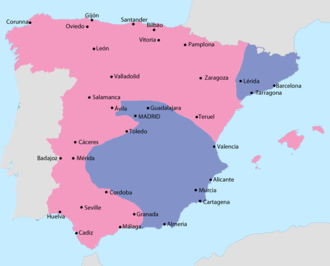
The Battle of Teruel was an important confrontation. The city, which had formerly belonged to the Nationalists, was conquered by Republicans in January. The Francoist troops launched an offensive and recovered the city by 22 February, but Franco was forced to rely heavily on German and Italian air support.[210]
On 7 March, Nationalists launched the Aragon Offensive, and by 14 April they had pushed through to the Mediterranean, cutting the Republican-held portion of Spain in two. The Republican government attempted to sue for peace in May,[211] but Franco demanded unconditional surrender, and the war raged on. In July, the Nationalist army pressed southward from Teruel and south along the coast toward the capital of the Republic at Valencia, but was halted in heavy fighting along the XYZ Line, a system of fortifications defending Valencia.[212]
The Republican government then launched an all-out campaign to reconnect their territory in the Battle of the Ebro, from 24 July until 26 November, where Franco personally took command.[213] The campaign was unsuccessful, and was undermined by the Franco-British appeasement of Hitler in Munich. The agreement with Britain effectively destroyed Republican morale by ending hope of an anti-fascist alliance with Western powers.[214] The retreat from the Ebro all but determined the final outcome of the war.[213] Eight days before the new year, Franco threw massive forces into an invasion of Catalonia.[215]
1939
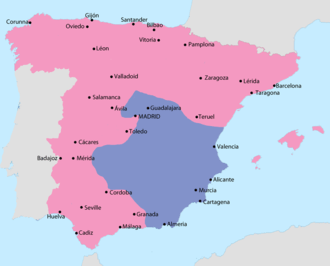
Franco's troops conquered Catalonia in a whirlwind campaign during the first two months of 1939. Tarragona fell on 15 January,[216] followed by Barcelona on 26 January[217] and Girona on 2 February.[218] On 27 February, the United Kingdom and France recognized the Franco regime.[219]
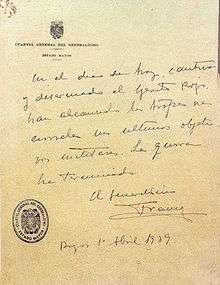
Only Madrid and a few other strongholds remained for the Republican forces. On 5 March 1939 the Republican army, led by the Colonel Segismundo Casado and the politician Julián Besteiro, rose against the prime minister Juan Negrín and formed the National Defence Council (Consejo Nacional de Defensa or CND) to negotiate a peace deal.[220] Negrín fled to France on 6 March,[221] but the Communist troops around Madrid rose against the junta, starting a brief civil war within the civil war.[222] Casado defeated them, and began peace negotiations with the Nationalists, but Franco refused to accept anything less than unconditional surrender.[223]
On 26 March, the Nationalists started a general offensive, on 28 March the Nationalists occupied Madrid and, by 31 March, they controlled all Spanish territory.[224] Franco proclaimed victory in a radio speech aired on 1 April, when the last of the Republican forces surrendered.[225]
After the end of the war, there were harsh reprisals against Franco's former enemies.[226] Thousands of Republicans were imprisoned and at least 30,000 executed.[227] Other calculations of these deaths range from 50,000[228] to 200,000, depending on which killings are included. Many others were put to forced labour, building railways, drying out swamps, and digging canals.[228]
Hundreds of thousands of Republicans fled abroad, with some 500,000 fleeing to France.[229] Refugees were confined in internment camps of the French Third Republic, such as Camp Gurs or Camp Vernet, where 12,000 Republicans were housed in squalid conditions. In his capacity as consul in Paris, Chilean poet and politician Pablo Neruda organized the immigration to Chile of 2,200 Republican exiles in France using the ship SS Winnipeg.[230]
Of the 17,000 refugees housed in Gurs, farmers and others who could not find relations in France were encouraged by the Third Republic, in agreement with the Franquist government, to return to Spain. The great majority did so and were turned over to the Franquist authorities in Irún.[231] From there, they were transferred to the Miranda de Ebro camp for "purification" according to the Law of Political Responsibilities. After the proclamation by Marshal Philippe Pétain of the Vichy regime, the refugees became political prisoners, and the French police attempted to round up those who had been liberated from the camp. Along with other "undesirable" people, the Spaniards were sent to the Drancy internment camp before being deported to Nazi Germany. About 5,000 Spaniards died in the Mauthausen concentration camp.[231]
After the official end of the war, guerrilla warfare was waged on an irregular basis by the Spanish Maquis well into the 1950s, gradually reduced by military defeats and scant support from the exhausted population. In 1944, a group of republican veterans, who also fought in the French resistance against the Nazis, invaded the Val d'Aran in northwest Catalonia, but were defeated after 10 days.[232]
Evacuation of children
.png)
The Republicans oversaw the evacuation of 30,000–35,000 children from their zone,[234] starting with Basque areas, from which 20,000 were evacuated. Their destinations included the United Kingdom[235] and the USSR, and many other locations in Europe, along with Mexico.[234] On 21 May 1937, around 4,000 Basque children were taken to the UK on the aging steamship SS Habana from the Spanish port of Santurtzi. This was against initial opposition from both the government and charitable groups, who saw the removal of children from their native country as potentially harmful. On arrival two days later in Southampton, the children were dispersed all over England, with over 200 children accommodated in Wales.[236] The upper age limit was initially set at 12, but raised to 15.[237] By mid-September, all of los niños, as they became known, had found homes with families. Most were repatriated to Spain after the war, but some 250 still remained in Britain by the end of the Second World War in 1945.[238]
Atrocities
Death totals remain debated. British historian Antony Beevor wrote in his history of the Civil War that Franco's ensuing "white terror" resulted in the deaths of 200,000 people and that the "red terror" killed 38,000.[239] Julius Ruiz contends that, "Although the figures remain disputed, a minimum of 37,843 executions were carried out in the Republican zone, with a maximum of 150,000 executions (including 50,000 after the war) in Nationalist Spain".[240]
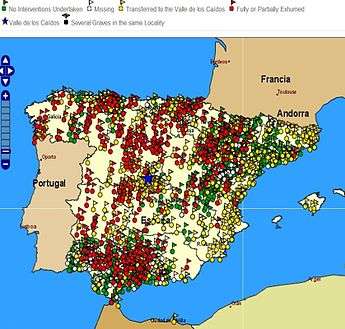
In 2008 a Spanish judge, Baltasar Garzón, opened an investigation into the executions and disappearances of 114,266 people between 17 July 1936 and December 1951. Among the executions investigated was that of the poet and dramatist Federico García Lorca, whose body has never been found.[3] Mention of García Lorca's death was forbidden during Franco's regime.[241]
Recent research has started to locate mass graves, using a combination of witness testimony, remote sensing and forensic geophysics techniques.[242]
The view of historians, including Helen Graham,[243] Paul Preston,[244] Antony Beevor,[245] Gabriel Jackson[246] and Hugh Thomas,[247] is that the mass executions behind the Nationalists lines were organized and approved by the Nationalists rebel authorities, while the executions behind the Republican lines were the result of the breakdown of the Republican state and anarchy:
Though there was much wanton killing in rebel Spain, the idea of the limpieza, the "cleaning up", of the country from the evils which had overtaken it, was a disciplined policy of the new authorities and a part of their programme of regeneration. In republican Spain, most of the killing was the consequence of anarchy, the outcome of a national breakdown, and not the work of the state, although some political parties in some cities abetted the enormities, and some of those responsible ultimately rose to positions of authority.
– Hugh Thomas[247]
Nationalists
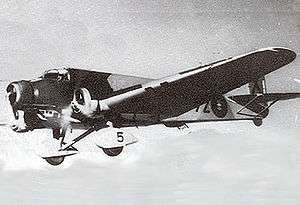
Nationalist atrocities, which authorities frequently ordered so as to eradicate any trace of "leftism" in Spain, were common. The notion of a limpieza (cleansing) formed an essential part of the rebel strategy, and the process began immediately after an area had been captured.[248] According to historian Paul Preston, the minimum number of those executed by the rebels is 130,000,[249] and is likely to have been far higher, with other historians placing the figure at 200,000 dead.[250] The violence was carried out in the rebel zone by the military, the Civil Guard and the Falange in the name of the regime.[251]
Many such acts were committed by reactionary groups during the first weeks of the war.[251] This included the execution of schoolteachers,[252] because the efforts of the Second Spanish Republic to promote laicism and displace the Church from schools by closing religious educational institutions were considered by the Nationalists as an attack on the Roman Catholic Church. Extensive killings of civilians were carried out in the cities captured by the Nationalists,[253] along with the execution of unwanted individuals. These included non-combatants such as trade-unionists, Popular Front politicians, suspected Freemasons, Basque, Catalan, Andalusian, and Galician Nationalists, Republican intellectuals, relatives of known Republicans, and those suspected of voting for the Popular Front.[251][254][255][256][257]
.jpg)
Nationalist forces massacred civilians in Seville, where some 8,000 people were shot; 10,000 were killed in Cordoba; 6,000–12,000 were killed in Badajoz [258] after more than one thousand of landowners and conservatives were killed by the revolutionaries. In Granada, where working-class neighborhoods were hit with artillery and right-wing squads were given free rein to kill government sympathizers,[259] at least 2,000 people were murdered.[252] In February 1937, over 7,000 were killed after the capture of Málaga.[260] When Bilbao was conquered, thousands of people were sent to prison. There were fewer executions than usual, however, because of the effect Guernica left on Nationalists' reputations internationally.[261] The numbers killed as the columns of the Army of Africa devastated and pillaged their way between Seville and Madrid are particularly difficult to calculate.[262]
Nationalists also murdered Catholic clerics. In one particular incident, following the capture of Bilbao, they took hundreds of people, including 16 priests who had served as chaplains for the Republican forces, to the countryside or graveyards and murdered them.[263][264]
Franco's forces also persecuted Protestants, including murdering 20 Protestant ministers.[265] Franco's forces were determined to remove the "Protestant heresy" from Spain.[266] The Nationalists also persecuted Basques, as they strove to eradicate Basque culture.[206] According to Basque sources, some 22,000 Basques were murdered by Nationalists immediately after the Civil War.[267]
The Nationalist side conducted aerial bombing of cities in Republican territory, carried out mainly by the Luftwaffe volunteers of the Condor Legion and the Italian air force volunteers of the Corpo Truppe Volontarie: Madrid, Barcelona, Valencia, Guernica, Durango, and other cities were attacked. The Bombing of Guernica was the most controversial.[268]
Republicans

According to the Nationalists, an estimated 55,000 civilians died in Republican-held territories. This is considered excessive by Antony Beevor. However, it was much less than the half a million claimed during the war.[270] The deaths would form the prevailing outside opinion of the republic up until the bombing of Guernica.[270]
The Republican government was anticlerical, and supporters attacked and murdered Roman Catholic clergy in reaction to the news of military revolt.[264] In his 1961 book, Spanish archbishop Antonio Montero Moreno, who at the time was director of the journal Ecclesia, wrote that 6,832 were killed during the war, including 4,184 priests, 2,365 monks and friars, and 283 nuns, in addition to 13 bishops, a figure accepted by historians, including Beevor.[265][271][272] Some sources claim that by the conflict's end, 20 percent of the nation's clergy had been killed,[273][nb 4] The "Execution" of the Sacred Heart of Jesus by Communist militiamen at Cerro de los Ángeles near Madrid, on 7 August 1936, was the most infamous of widespread desecration of religious property.[274] In dioceses where the Republicans had general control, a large proportion – often a majority – of secular priests were killed.[275]
Like clergy, civilians were executed in Republican territories. Some civilians were executed as suspected Falangists.[276] Others died in acts of revenge after Republicans heard of massacres carried out in the Nationalist zone.[277] Air raids committed against Republican cities were another driving factor.[278] Shopkeepers and industrialists were shot if they did not sympathize with the Republicans, and were usually spared if they did.[279] Fake justice was sought through a commission, known in Russia as checas.[276]
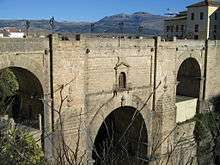
As pressure mounted with the increasing success of the Nationalists, many civilians were executed by councils and tribunals controlled by competing Communist and anarchist groups.[276] Some members of the latter were executed by Soviet-advised communist functionaries in Catalonia,[280] as recounted by George Orwell's description of the purges in Barcelona in 1937 in Homage to Catalonia, which followed a period of increasing tension between competing elements of the Catalan political scene. Some individuals fled to friendly embassies, which would house up to 8,500 people during the war.[277]
In the Andalusian town of Ronda, 512 suspected Nationalists were executed in the first month of the war.[280] Communist Santiago Carrillo Solares was accused of the killing of Nationalists in the Paracuellos massacre near Paracuellos del Jarama.[281] Pro-Soviet Communists committed numerous atrocities against fellow Republicans, including other Marxists: André Marty, known as the Butcher of Albacete, was responsible for the deaths of some 500 members of the International Brigades.[282] Andreu Nin, leader of the POUM (Workers' Party of Marxist Unification), and many other prominent POUM members, were murdered by the Communists, with the help of the USSR's NKVD.[283]
Thirty-eight thousand people were killed in the Republican zone during the war, 17,000 of whom were killed in Madrid or Catalonia within a month of the coup. Whilst the Communists were forthright in their support of extrajudicial killings, much of the Republican side was appalled by the murders.[284] Azaña came close to resigning.[277] He, alongside other members of Parliament and a great number of other local officials, attempted to prevent Nationalist supporters being lynched. Some of those in positions of power intervened personally to stop the killings.[284]
Social revolution
In the anarchist-controlled areas, Aragon and Catalonia, in addition to the temporary military success, there was a vast social revolution in which the workers and peasants collectivised land and industry and set up councils parallel to the paralyzed Republican government.[285] This revolution was opposed by the Soviet-supported communists who, perhaps surprisingly, campaigned against the loss of civil property rights.[285]
As the war progressed, the government and the communists were able to exploit their access to Soviet arms to restore government control over the war effort, through diplomacy and force.[283] Anarchists and the Workers' Party of Marxist Unification (Partido Obrero de Unificación Marxista, POUM) were integrated into the regular army, albeit with resistance. The POUM Trotskyists were outlawed and falsely denounced as an instrument of the fascists.[283] In the May Days of 1937, many thousands of anarchist and communist Republican soldiers fought for control of strategic points in Barcelona.[201]
The pre-war Falange was a small party of some 30,000–40,000 members.[286] It also called for a social revolution that would have seen Spanish society transformed by National Syndicalism.[287] Following the execution of its leader, José Antonio Primo de Rivera, by the Republicans, the party swelled in size to several hundred thousand members.[288] The leadership of the Falange suffered 60 percent casualties in the early days of the civil war, and the party was transformed by new members and rising new leaders, called camisas nuevas ("new shirts"), who were less interested in the revolutionary aspects of National Syndicalism.[289] Subsequently, Franco united all fighting groups into the Traditionalist Spanish Falange and the National Syndicalist Offensive Juntas (Spanish: Falange Española Tradicionalista de las Juntas de Ofensiva Nacional-Sindicalista, FET y de las JONS).[290]
The 1930s also saw Spain become a focus for pacifist organizations, including the Fellowship of Reconciliation, the War Resisters League, and the War Resisters' International. Many people including, as they are now called, the "insumisos" ("defiant ones", conscientious objectors) argued and worked for non-violent strategies. Prominent Spanish pacifists, such as Amparo Poch y Gascón and José Brocca, supported the Republicans. Brocca argued that Spanish pacifists had no alternative but to make a stand against fascism. He put this stand into practice by various means, including organizing agricultural workers to maintain food supplies, and through humanitarian work with war refugees.[nb 5]
Art and propaganda

Throughout the course of the Spanish Civil War, people all over the world were exposed to the goings-on and effects of it on its people not only through standard art, but also through propaganda. Motion pictures, posters, books, radio programs, and leaflets are a few examples of this media art that was so influential during the war. Produced by both nationalists and republicans, propaganda allowed Spaniards a way to spread awareness about their war all over the world. A film co-produced by famous early-twentieth century authors such as Ernest Hemingway and Lillian Hellman was used as a way to advertise Spain's need for military and monetary aid. This film, The Spanish Earth, premiered in America in July 1937. In 1938, George Orwell's Homage to Catalonia, a personal account of his experiences and observations in the war, was published in the United Kingdom.
Leading works of sculpture include Alberto Sánchez Pérez's El pueblo español tiene un camino que conduce a una estrella maqueta ("The Spanish People Have a Path that Leads to a Star"), a 12.5m monolith constructed out of plaster representing the struggle for a socialist utopia;[291] Julio González's La Montserrat, an anti-war work which shares its title with a mountain near Barcelona, is created from a sheet of iron which has been hammered and welded to create a peasant mother carrying a small child in one arm and a sickle in the other. and Alexander Calder's Fuente de mercurio (Mercury Fountain) a protest work by the American against the Nationalist forced control of Almade'n and the mercury mines there.[292]
As to other works of art, Pablo Picasso painted Guernica in 1937, taking inspiration from the bombing of Guernica, and in Leonardo de Vinci's The Battle of Anghiari. Guernica, like many important Republican masterpieces, was featured at the 1937 International Exhibition in Paris. The work's size (11 ft by 25.6 ft) grabbed much attention and cast the horrors of the mounting Spanish civil unrest into a global spotlight.[293] The painting has since been heralded as an anti-war work and a symbol of peace in the 20th century.[294]
Joan Miró created El Segador (The Reaper), formally titled El campesino catalán en rebeldía (Catalan peasant in revolt), which spans some 18 feet by 12 feet[295] and depicted a peasant brandishing a sickle in the air, to which Miró commented that "The sickle is not a communist symbol. It is the reaper's symbol, the tool of his work, and, when his freedom is threatened, his weapon."[296] This work, also featured at the 1937 International Exhibition in Paris, was shipped back to the Spanish Republic's capital in Valencia following the Exhibition, but has since gone missing or has been destroyed.[295]
Timeline
Spanish Civil War Timeline
| Date | Event |
|---|---|
| 1868 | Overthrow of Queen Isabella II of the House of Bourbon |
| 1873 | Isabella's replacement, King Amadeo I of the House of Savoy, abdicates throne ending the short-lived First Spanish Republic |
| 1874 | (December) Restoration of the Bourbons |
| 1909 | Tragic Week in Barcelona |
| 1923 | Military coup brings Miguel Primo de Rivera to power |
| 1930 | (January) Miguel Primo de Rivera resigns |
| 1931 | (12 April) Municipal elections, King Alfonso XIII abdicates, Second Spanish Republic is formed with Niceto Alcala-Zamora as President and Head of State |
| 1931 | (June) Elections return large majority of Republicans and Socialists |
| 1931 | (October) Republican Manuel Azaña becomes prime minister of a minority government |
| 1931 | (December) New reformist, liberal, and democratic constitution is declared |
| 1932 | (August) Unsuccessful uprising by General José Sanjurjo |
| 1933 | Beginning of the "black two years" |
| 1934 | Asturias uprising |
| 1936 | (April) Popular Front alliance wins election and Azaña replaces Zamora as president |
| 1936 | (14 April) During a military parade commemorating the 5 years of the second republic, Guardia Civil lieutenant Anastasio de los Reyes is shot in the back by anarchist/socialist agitators. Riots break out at the funeral |
| 1936 | (12 June) Prime Minister Casares Quiroga meets General Joan Yague |
| 1936 | (5 July) Aircraft chartered to take Franco from the Canary Islands to Morocco |
| 1936 | (12 July) Assault Guard Lieutenant Jose Castillo is murdered after he violently put down the riots that broke out at the funeral of Guardia Civil lieutenant Anastasio de los Reyes |
| 1936 | (13 July) Opposition leader Jose Calvo Sotelo is arrested and murdered by the socialist Assault Guards (Guardia de Asalto), freemason police officer Burillo also blamed. |
| 1936 | (14 July) Franco arrives in Morocco |
| 1936 | (17 July) Military coup gains control over Spanish Morocco |
| 1936 | (17 July) Official beginning of the war |
| 1936 | (20 July) Coup leader Sanjurjo is killed in a plane crash |
| 1936 | (21 July) Nationalists capture the central Spanish naval base |
| 1936 | (7 August) "Execution" of the Sacred Heart of Jesus by Communist militiamen at Cerro de los Angeles in Getafe |
| 1936 | (4 September) The Republican government under Giral resigns, and are replaced by mostly Socialist organization under Largo Caballero |
| 1936 | (5 September) Nationalists take Irun |
| 1936 | (15 September) Nationalists take San Sebastian |
| 1936 | (21 September) Franco chosen as chief military commander at Salamanca |
| 1936 | (27 September) Franco's troops relieve the Alcazar in Toledo |
| 1936 | (29 September) Franco proclaims himself Caudillo |
| 1936 | (17 October) Nationalists from Galicia relieve the besieged town of Oviedo |
| 1936 | (November) Bombing of Madrid |
| 1936 | (8 November) Franco launches major assault on Madrid that is unsuccessful |
| 1936 | (6 November) Republican government is forced to move to Valencia from Madrid |
| 1937 | Nationalists capture most of Spain's northern coastline |
| 1937 | (6 February) Battle of Jarama begins |
| 1937 | (8 February) Malaga falls to Franco's forces |
| 1937 | (March) War in the North begins |
| 1937 | (8 March) Battle of Guadalajara begins |
| 1937 | (26 April) Bombing of Guernica |
| 1937 | (21 May) 4,000 Basque children taken to the UK |
| 1937 | (3 June) Mola, Franco's second-in-command, is killed |
| 1937 | (July) Republicans move to recapture Segovia |
| 1937 | (6 July) Battle of Brunete begins |
| 1937 | (August) Franco invades Aragon and takes the city of Santander |
| 1937 | (24 August) Battle of Belchite begins |
| 1937 | (October) Gijon falls to Franco's troops |
| 1937 | (November) Republican government forced to move to Barcelona from Valencia |
| 1938 | Nationalists capture large parts of Catalonia |
| 1938 | (January) Battle of Teruel, conquered by Republicans |
| 1938 | (22 February) Franco recovers Teruel |
| 1938 | (7 March) Nationalists launch the Aragon Offensive |
| 1938 | (16 March) Bombing of Barcelona |
| 1938 | (May) Republican sue for peace, Franco demands unconditional surrender |
| 1938 | (24 July) Battle of the Ebro begins |
| 1938 | (24 December) Franco throws massive force into invasion of Catalonia |
| 1939 | Beginning of General Francisco Franco's rule |
| 1939 | (15 January) Tarragona falls to Franco |
| 1939 | (26 January) Barcelona falls to Franco |
| 1939 | (2 February) Girona falls to Franco |
| 1939 | (27 February) UK and France recognize the Franco regime |
| 1939 | (6 March) Prime minister Juan Negrin flees to France |
| 1939 | (28 March) Nationalists occupy Madrid |
| 1939 | (31 March) Nationalists control all Spanish territory |
| 1939 | (1 April) Last Republican forces surrender |
| 1939 | (1 April) Official ending of the war |
| 1975 | Ending of General Francisco Franco's rule with his death in November 20, La Paz hospital, Madrid |
People
|
Figures identified with the Republican side
Others identified with the Republican side (including volunteers)
|
Figures identified with the Nationalist side
|
Political parties and organizations
| The Popular Front (Republican) | Supporters of the Popular Front (Republican) | Nationalists (Francoist) |
|
The Popular Front was an electoral alliance formed between various left-wing and centrist parties for elections to the Cortes in 1936, in which the alliance won a majority of seats.
|
|
Virtually all Nationalist groups had very strong Roman Catholic convictions and supported the native Spanish clergy.
|
See also
- List of foreign ships wrecked or lost in the Spanish Civil War
- Catholicism in the Second Spanish Republic
- Guernica (painting)
- The Falling Soldier
- Foreign involvement in the Spanish Civil War
- List of war films and TV specials#Spanish Civil War (1936–1939)
- List of foreign correspondents in the Spanish Civil War
- List of surviving veterans of the Spanish Civil War
- List of non-participants who died defending their freedom of conscience
- Polish volunteers in the Spanish Civil War
- Jewish volunteers in the Spanish Civil War
- European Civil War
- Spain in World War II
- SS Cantabria
- Pacifism in Spain
- Spanish Republican Armed Forces
- Art and culture in Francoist Spain
References
Notes
- ↑ Also known as The Crusade (Spanish: La Cruzada) among Nationalists, the Fourth Carlist War (Spanish: Cuarta Guerra Carlista) among Carlists, and The Rebellion (Spanish: La Rebelión) or Uprising (Spanish: Sublevación) among Republicans.
- ↑ Known in Spanish as the Falange Española de las JONS.
- ↑ Westwell (2004) gives a figure of 500 million Reichmarks.
- ↑ Since Beevor (2006). p. 82. suggests 7,000 members of some 115,000 clergy were killed, the proportion could well be lower.
- ↑ See variously: Bennett, Scott, Radical Pacifism: The War Resisters League and Gandhian Nonviolence in America, 1915–1963, Syracuse NY, Syracuse University Press, 2003; Prasad, Devi, War is A Crime Against Humanity: The Story of War Resisters' International, London, WRI, 2005. Also see Hunter, Allan, White Corpsucles in Europe, Chicago, Willett, Clark & Co., 1939; and Brown, H. Runham, Spain: A Challenge to Pacifism, London, The Finsbury Press, 1937.
Citations
- ↑ Thomas (1961). p. 491.
- ↑ Thomas (1961). p. 488.
- 1 2 "Spanish judge opens case into Franco's atrocities". New York Times. 16 October 2008. Retrieved 28 July 2009.
- ↑ The number of casualties is disputed; estimates generally suggest that between 500,000 and 1 million people were killed. Over the years, historians kept lowering the death figures and modern research concludes that 500,000 deaths is the correct figure. Thomas Barria-Norton, The Spanish Civil War (2001), pp. xviii & 899–901, inclusive.
- ↑ Beevor (2006). pp. 410–11. Beevor notes that around 150,000 had returned by 1939.
- ↑ Payne (2012). p. 231.
- 1 2 Payne (1973). pp. 200–203.
- ↑ Beevor (2006). p. 88.
- ↑ Beevor (2006). pp. 86–87.
- ↑ Beevor (2006). pp. 260–271.
- ↑ Julius Ruiz. El Terror Rojo (2011). pp. 200–211.
- 1 2 Beevor (2006). p. 7.
- ↑ Preston (2006). p. 19.
- ↑ Thomas (1961). p. 13.
- ↑ Preston (2006). p. 21.
- ↑ Preston (2006). p. 22.
- ↑ Preston (2006). p. 24.
- ↑ Fraser (1979). pp. 38–39.
- ↑ Preston (2006). pp. 24–26.
- ↑ Thomas (1961). p. 15.
- ↑ Preston (2006). pp. 32–33.
- ↑ Beevor (2006). p. 15.
- ↑ Thomas (1961). p. 16.
- ↑ Beevor (2006) p. 20-22.
- ↑ Beevor (2006). p. 20.
- ↑ Beevor (2006) p. 23.
- ↑ Preston (2006). pp. 38–39.
- ↑ Beevor (2006) p.26.
- ↑ Preston (2006). p. 50.
- ↑ Preston (2006). p. 42.
- ↑ Beevor (2006). p. 22.
- ↑ Preston (2006). pp. 45–48.
- ↑ Preston (2006). p. 53.
- ↑ Thomas (1961). p. 47.
- ↑ Preston (2006). p. 61.
- ↑ Casanova (2010). p. 90.
- ↑ Preston (2006). pp. 54–55.
- ↑ Hansen, Edward C. (2 January 1984). "The Anarchists of Casas Viejas (Book Review)". Ethnohistory. 31 (3): 235–236. doi:10.2307/482644. Retrieved 13 August 2015.
- ↑ Beevor (2006). p. 27.
- ↑ Preston (2006). pp. 66–67.
- ↑ Preston (2006). pp. 67–68.
- ↑ Preston (2006). pp. 63–65.
- ↑ Thomas (1961). p. 62.
- ↑ Preston (2006). pp. 69–70.
- ↑ Preston (2006). p. 70.
- ↑ Preston (2006). p. 83.
- ↑ Thomas (1961). p. 78.
- 1 2 3 Preston (2006). p. 81.
- ↑ Preston (2006). pp. 82–83.
- ↑ Payne (1973). p. 642.
- ↑ Preston (2006). p. 93.
- 1 2 3 4 Preston (2006). p. 94.
- 1 2 3 4 5 6 Preston (1983). pp. 4–10.
- ↑ Preston (2006). pp. 94–95.
- ↑ Preston (2006). p. 95.
- 1 2 Preston (2006). p. 96.
- ↑ Alpert, Michael BBC History Magazine April 2002
- 1 2 Preston (2006). p. 98.
- 1 2 3 4 5 Preston (2006). p. 99.
- ↑ Thomas (2001). pp. 196–198, 309
- ↑ Thomas (2001). pp. 196–198, 309.
- ↑ Thomas (1961). p. 126.
- ↑ Beevor (2006). pp. 55–56.
- 1 2 Preston (2006). p. 102.
- 1 2 Beevor (2006). p. 56.
- ↑ Beevor (2006). pp. 56–57.
- ↑ Beevor (2006). pp. 58–59.
- ↑ Beevor (2006). p. 59.
- ↑ Beevor (2006). pp. 60–61.
- ↑ Beevor (2006). p. 62.
- ↑ Chomsky (1969).
- ↑ Beevor (2006). p. 69.
- ↑ Beevor (2001) pp. 55-61
- ↑ Preston (2006). pp. 102–3.
- ↑ Westwell (2004). p. 9.
- 1 2 Howson (1998). p. 28.
- ↑ Westwell (2004). p. 10.
- ↑ Howson (1998). p. 20.
- 1 2 Howson (1998). p. 21.
- ↑ Michael Alpert, La Guerra Civil española en el mar, Editorial Critica , ISBN 978-84-8432-975-6
- ↑ Howson (1998). pp. 21–22.
- 1 2 3 Beevor (2006). Chapter 21.
- ↑ Beevor (1982). pp. 42–43.
- ↑ Payne, Stanley G. (1970), The Spanish Revolution, OCLC 54588, p. 315
- ↑ Payne (1970), p. 315
- ↑ Payne (1970), pp. 329-330
- ↑ Payne (2012), p. 188
- ↑ Payne (2012), p. 299
- ↑ Payne (1970), p. 360
- ↑ Payne (1987), p. 244
- 1 2 Payne (1970), p. 343
- ↑ Salas Larrazábal, Ramón (1980), Datos exactos de la Guerra civil, ISBN 9788430026944, pp. 288-289
- ↑ Larrazábal (1980), pp. 288-289
- ↑ Beevor (2006). pp. 30–33.
- ↑ Howson (1997). p. 2.
- ↑ Cohen (2012). pp. 164–165.
- ↑ Thomas (1987). pp. 86–90.
- ↑ Orden, circular, creando un Comisariado general de Guerra con la misión que se indica [Order, circular, creating a general comisariat of war with the indicated mission] (PDF) (in Spanish). IV. Gaceta de Madrid: diario oficial de la República. 16 October 1936. p. 355.
- ↑ Dawson (2013). p. 85.
- ↑ Alpert (2013). p. 167.
- ↑ Pétrement, Simone (1988). Simone Weil: A Life. Schocken Books. pp. 271–278. ISBN 9780805208627.
- 1 2 3 Howson (1998). pp.1–2.
- ↑ Werstein (1969) p. 44
- ↑ Payne (1973) p. 637.
- ↑ Coverdale (2002). p. 148.
- ↑ Preston (2006). p. 79.
- ↑ Payne (2008). p. 13.
- ↑ Rooney, Nicola. "The role of the Catholic hierarchy in the rise to power of General Franco" (PDF). Queen's University, Belfast.
- ↑ "Morocco tackles painful role in Spain's past," Reuters 14 January 2009.
- ↑ Peers, E. Allison; Hogan, James (December 1936). "The Basques and the Spanish Civil War" (PDF). Studies: an Irish Quarterly Review. Irish Province of the Society of Jesus. 25 (100): 540–542. ISSN 0039-3495.
- ↑ Zara Steiner, The Triumph of the Dark: European International History 1933–1939 (Oxford History of Modern Europe) (2013), pp 181–251.
- ↑ Emanuel Adler and Vincent Pouliot (2011). International Practices. Cambridge University Press. pp. 184–85. doi:10.1017/CBO9780511862373. ISBN 9781139501583.
- ↑ Stone (1997). p. 133.
- ↑ "Spain:Business & Blood". Time. 19 April 1937. Retrieved 3 August 2011.
- ↑ Jackson (1974). p. 194.
- ↑ Stoff (2004). p. 194.
- ↑ Zara Steiner, The Triumph of the Dark: European International History 1933–1939 (2013) pp 181–251
- 1 2 Westwell (2004). p. 87.
- ↑ "The legacy of Guernica". BBC website. BBC. 26 April 2007. Retrieved 6 June 2011.
- ↑ Musciano, Walter. "Spanish Civil War: German Condor Legion's Tactical Air Power", History Net, 2004. Retrieved on 2 July 2015.
- ↑ Westwell (2004). p. 88.
- 1 2 3 Thomas (1961). p. 634.
- ↑ Thomas, Hugh. (2001). The Spanish Civil War. Penguin Books. London. p. 937
- ↑ Beevor (2006). pp. 135–6.
- 1 2 Beevor (2006). p. 199.
- ↑ Balfour, Sebastian; Preston, Paul (2009). Spain and the great powers in the twentieth century. London, UK; New York, USA: Routledge. p. 172. ISBN 978-0-415-18078-8.
- ↑ Thomas (2001). pp. 938–939.
- ↑ Beevor (2006). pp. 116, 133, 143, 148, 174, 427.
- 1 2 Thomas (1961). p. 635.
- ↑ Beevor (2006). p. 198.
- 1 2 Beevor (2006). p. 116.
- ↑ David Deacon, British News Media and the Spanish Civil War (2008) p 171
- ↑ Richard Overy, The Twilight Years: The Paradox of Britain Between the Wars (2009) pp 319–40
- ↑ A. J. P. Taylor, English History 1914–1945 (1965) pp 393–98
- ↑ Othen (2008). p. 102.
- ↑ Casanova (2010). p. 225.
- ↑ Mittermaier (2010). p. 195.
- 1 2 3 Thomas (1961). p. 637.
- ↑ Thomas (1961). pp. 638–639.
- ↑ Deletant (1999). p. 20.
- ↑ Review of O'Riordan's memoir
- ↑ Benton, Pieke (1998). p. 215.
- ↑ Howson (1998). p. 125.
- ↑ Payne (2004). p. 156.
- 1 2 Payne (2004). pp. 156–157.
- 1 2 Beevor (2006). pp. 152–153.
- ↑ Howson (1998). pp. 126–129.
- ↑ Howson (1998). p. 134.
- ↑ Beevor (2006). pp. 153–154.
- ↑ Beevor (2006). p. 163.
- ↑ Graham (2005). p. 92.
- ↑ Thomas (2003). p. 944.
- ↑ Richardson (2015). pp. 31–40
- ↑ Beevor (2006). p. 273.
- ↑ Beevor (2006). p. 246.
- ↑ VIDAL, Cesar. La guerra que gano Franco. Madrid, 2008. p.256
- 1 2 3 Beevor (2006). pp. 139–14.
- ↑ Beevor (2006). p. 291.
- ↑ Beevor (2006). pp. 412–413.
- 1 2 Alpert (1994). p. 14.
- ↑ Alpert (1994). pp. 14–15.
- ↑ Alpert (1994). pp. 20, 23.
- 1 2 Alpert (1994). p. 41.
- 1 2 Alpert (1994). p. 43.
- ↑ Potez 540/542
- ↑ Alpert (1994). pp. 46–47.
- ↑ Werstein (1969). p. 139.
- ↑ Alpert (1994). p. 47.
- ↑ Payne (2008). p. 28.
- ↑ Lukeš, Goldstein (1999). p. 176.
- ↑ Beevor (2006). p. 71.
- ↑ Beevor (2006). p. 96.
- ↑ Thomas (1961). p. 162.
- ↑ Red: Beevor (2006). pp. 81–87.
- ↑ White: Beevor (2006). pp. 88–94.
- ↑ Beevor (2006). pp. 73–74.
- ↑ Beevor (2006). pp. 116–117.
- 1 2 Beevor (2006). p. 144
- ↑ Beevor (2006). pp. 146–147.
- 1 2 Beevor (2006). p. 143
- ↑ Timmermans, Rodolphe. 1937. Heroes of the Alcazar. Charles Scribner's Sons, New York
- ↑ Beevor (2006). p. 121
- ↑ Casanova (2010). p. 109.
- ↑ Cleugh (1962). p. 90.
- ↑ Beevor (2006). p. 150
- ↑ Beevor (2006). p. 177
- ↑ Beevor (2006). p. 171.
- ↑ Comín Colomer, Eduardo (1973); El 5º Regimiento de Milicias Populares. Madrid.
- ↑ Beevor (2006). pp. 177–183.
- ↑ Beevor (2006). pp. 191–192.
- ↑ Beevor (2006). pp. 200–201.
- ↑ Beevor (2006). p. 202.
- ↑ Beevor (2006). pp. 208–215.
- ↑ Beevor (2006). pp. 216–221.
- ↑ Beevor (2006). p. 222.
- ↑ Beevor (2006). pp. 223–226.
- ↑ Beevor (2006). p. 228.
- ↑ Beevor (2006). p. 229.
- ↑ Beevor (2006). pp. 231–232.
- ↑ Beevor (2006). p. 233.
- 1 2 Beevor (2006). pp. 263–273.
- ↑ Beevor (2006). p. 277.
- ↑ Beevor (2006). p. 235.
- ↑ Beevor (2006). pp. 277–284.
- ↑ Beevor (2006). pp. 296–299.
- 1 2 Beevor (2006). p. 237.
- ↑ Beevor (2006). pp. 237–238.
- ↑ Beevor (2006). p. 302.
- ↑ Payne (1973).
- ↑ Beevor (2006). pp. 315–322.
- ↑ Thomas (2003). pp. 820–821.
- ↑ Beevor (2006). pp. 346–7.
- 1 2 Beevor (2006). pp. 349–359.
- ↑ Beevor (2006). p. 362.
- ↑ Beevor (2006). p. 374.
- ↑ Beevor (2006). p. 376.
- ↑ Beevor (2006). p. 378.
- ↑ Beevor (2006). p. 380.
- ↑ Beevor (2006). p. 386.
- ↑ Beevor (2006). pp. 391–392.
- ↑ Thomas (2003), pp. 879–882.
- ↑ Beevor (2001). p. 256
- ↑ Beevor (2006). pp. 394–395.
- ↑ Beevor (2006). pp. 396–397.
- ↑ Derby (2009). p. 28.
- ↑ Professor Hilton (27 October 2005). "Spain: Repression under Franco after the Civil War". Cgi.stanford.edu. Retrieved 24 June 2009.
- ↑ Tremlett, Giles (1 December 2003). "Spain torn on tribute to victims of Franco". London: Guardian. Retrieved 24 June 2009.
- 1 2 Beevor (2006). p. 405.
- ↑ Caistor, Nick (28 February 2003). "Spanish Civil War fighters look back". BBC News. Retrieved 24 June 2009.
- ↑ Winnipeg, el poema que cruzó el Atlántico (Spanish)
- 1 2 Film documentary on the website of the Cité nationale de l'histoire de l'immigration (French)
- ↑ Beevor (2006). pp. 421–422.
- ↑ "The Roman salute characteristic of Italian fascism was first adopted by the PNE and the JONS, later spreading to the Falange and other extreme right groups, before it became the official salute in Franco's Spain. The JAP salute, which consisted of stretching the right arm horizontally to touch the left shoulder enjoyed only relatively little acceptance. The gesture of the raised fist, so widespread among left-wing workers' groups, gave rise to more regimented variations, such as the salute with the fist on one's temple, characteristic of the German Rotfront, which was adopted by the republican Popular Army". The Splintering of Spain, p. 36–37
- 1 2 Daniel Kowalsky. "The Evacuation of Spanish Children to the Soviet Union". Gutenburg E. Columbia University Press. Retrieved 16 August 2011.
- ↑ "History of the arrival of the Basque Children to England in 1937". BasqueChildren.org. Basque Children of '37 Association. Retrieved 16 August 2011.
- ↑ "Wales and the refugee children of the Basque country". BBC Wales. 2012-12-03. Retrieved 2016-05-27.
- ↑ Buchanan (1997). pp. 109–110.
- ↑ "Los Niños of Southampton". The Dustbin of History. Retrieved 2016-05-29.
- ↑ "Men of La Mancha". The Economist. 22 June 2006. Retrieved 3 August 2011.
- ↑ Julius Ruiz (2007). "Defending the Republic: The García Atadell Brigade in Madrid, 1936". Journal of Contemporary History. 42 (1): 97. doi:10.1177/0022009407071625.
- ↑ Beevor (2006). p. 92.
- ↑ Fernández-Álvarez, José-Paulino; Rubio-Melendi, David; Martínez-Velasco, Antxoka; Pringle, Jamie K.; Aguilera, Hector-David. "Discovery of a mass grave from the Spanish Civil War using Ground Penetrating Radar and forensic archaeology". Forensic Science International. 267: e10–e17. doi:10.1016/j.forsciint.2016.05.040.
- ↑ Graham (2005). p. 30.
- ↑ Preston (2006). p. 307.
- ↑ Beevor (2006). pp. 86–87.
- ↑ Jackson (1967). p. 305.
- 1 2 Thomas (2001). p. 268.
- ↑ Beevor (2006). p. 98
- ↑ Paul Preston (19 January 2008). "Paul Preston lecture: The Crimes of Franco" (PDF). Retrieved 16 August 2011.
- ↑ Beevor (2006). p. 94.
- 1 2 3 Beevor (2006). pp. 88–89.
- 1 2 Beevor (2006). p. 89.
- ↑ Preston (2007). p. 121.
- ↑ Jackson (1967). p. 377.
- ↑ Thomas (2001). pp. 253–255.
- ↑ Santos et al. (1999). p. 229.
- ↑ Preston (2006). pp. 120–123.
- ↑ Beevor (2006). p. 91.
- ↑ Balfour, Sebastian. "Spain from 1931 to the Present". Spain: a History. Ed. Raymond Carr. New York: Oxford University Press, 2000. 257. Print.
- ↑ Beevor (2006). p. 93.
- ↑ Beevor (2006). pp. 236–237.
- ↑ Preston (2006). p. 302.
- ↑ Bieter, Bieter (2003). p. 91.
- 1 2 Beevor (2006). pp. 82–83.
- 1 2 Beevor (2006). p. 82.
- ↑ Seidman (2011). p. 205.
- ↑ Wieland (2002). p. 47.
- ↑ Westwell (2004). p. 31.
- ↑ "Shots of War: Photojournalism During the Spanish Civil War". Orpheus.ucsd.edu. Retrieved 24 June 2009.
- 1 2 Beevor (2006). p. 81.
- ↑ Antonio Montero Moreno, Historia de la persecucion religiosa en Espana 1936–1939 (Madrid: Biblioteca de Autores Cristianos, 1961)
- ↑ Payne (1973). p. 649.
- ↑ Bowen (2006). p. 22.
- ↑ Ealham, Richards (2005). pp. 80, 168.
- ↑ Hubert Jedin; John Dolan (1981). History of the Church. Continuum. p. 607. ISBN 9780860120926.
- 1 2 3 Beevor (2006). p. 84.
- 1 2 3 Beevor (2006). p. 85.
- ↑ Preston (2006).
- ↑ Beevor (2006). p. 83.
- 1 2 3 Thomas (1961). p. 176.
- ↑ Beevor (2006). pp. 172–173.
- ↑ Beevor (2006). p. 161.
- 1 2 3 Beevor (2006). pp. 272–273.
- 1 2 Beevor (2006). p. 87.
- 1 2 Beevor (2006). pp. 102–122.
- ↑ Beevor (2006). p. 40.
- ↑ Payne (1999). p. 151.
- ↑ Beevor (2006). p. 253.
- ↑ Arnaud Imatz, "La vraie mort de Garcia Lorca" 2009 40 NRH, 31–34, pp. 32–33.
- ↑ Beevor (2006). p. 255.
- ↑ Museo Nacional Centro de Arte Reina Sofia, El pueblo español tiene un camino que conduce a una estrella (maqueta) (There Is a Way for the Spanish People That Leads to a Star [Maquette]).
- ↑ Museum of Modern Art.
- ↑ Pablo Picasso.
- ↑ SUNY Oneota, Picasso´s Guernica.
- 1 2 Stanley Meisler, For Joan Miro, Painting and Poetry Were the Same.
- ↑ TATE, 'The Reaper': Miró's Civil War protest.
Bibliography and books by noted authors
- Alpert, Michael (2004) [1994]. A New International History of the Spanish Civil War. Basingstoke: Palgrave Macmillan. ISBN 1-4039-1171-1. OCLC 155897766.
- Alpert, Michael (2013). The Republican Army in the Spanish Civil War, 1936–1939. Cambridge: Cambridge University Press. ISBN 9781107028739.
- Beevor, Antony (2001) [The Spanish Civil War (1982)]. The Spanish Civil War. London: Penguin Group. ISBN 0-14-100148-8.
- Beevor, Antony (2006) [The Spanish Civil War (1982)]. The Battle for Spain: The Spanish Civil War 1936–1939. London: Weidenfield & Nicolson. ISBN 0-297-84832-1.
- Benton, Gregor; Pieke, Frank N. (1998). The Chinese in Europe. Macmillan. p. 390. ISBN 0-333-66913-4. Retrieved 14 July 2010.
- Bieter, John; Bieter, Mark (2003). An Enduring Legacy: The Story of Basques in Idaho. University of Nevada Press. ISBN 978-0-87417-568-4.
- Bolloten, Burnett (1979). The Spanish Revolution. The Left and the Struggle for Power during the Civil War. University of North Carolina. ISBN 1-84212-203-7.
- Borkenau, Franz (1937). The Spanish Cockpit : an Eye-Witness Account of the Political and Social Conflicts of the Spanish Civil War. London: Faber and Faber.
- Bowen, Wayne H (2006). Spain During World War II. University of Missouri Press. ISBN 978-0-8262-1658-8.
- Brenan, Gerald (1993) [1943]. The Spanish Labyrinth: an account of the social and political background of the Civil War. Cambridge: Cambridge University Press. ISBN 978-0-521-39827-5. OCLC 38930004.
- Buchanan, Tom (1997). Britain and the Spanish Civil War. Cambridge, UK: Cambridge University Press. ISBN 0-521-45569-3.
- Casanova, Julián (2010). The Spanish Republic and Civil War. Cambridge, New York: Cambridge University Press. ISBN 9780521737807.
- Cleugh, James (1962). Spanish Fury: The Story of a Civil War. London: Harrap. OCLC 2613142.
- Cohen, Yehuda (2012). The Spanish: Shadows of Embarrassment. Brighton: Sussex Academic Press. ISBN 9781845193928.
- Coverdale, John F. (2002). Uncommon faith: the early years of Opus Dei, 1928–1943. New York: Scepter. ISBN 978-1-889334-74-5.
- Cox, Geoffrey (1937). The Defence of Madrid. London: Victor Gollancz. OCLC 4059942.
- Dawson, Ashley (2013). The Routledge Concise History of Twentieth-century British Literature. New York: Routledge. ISBN 9780415572453.
- Derby, Mark (2009). Kiwi Companeros: New Zealand and the Spanish Civil War. Christchurch, New Zealand: Canterbury University Press. ISBN 9781877257711.
- Ealham, Chris; Richards, Michael (2005). The Splintering of Spain. Cambridge University Press. doi:10.1017/CBO9780511497025. ISBN 978-0-521-82178-0.
- Graham, Helen (2005). The Spanish Civil War: A very short introduction. New York: Oxford University Press. doi:10.1093/actrade/9780192803771.001.0001. ISBN 978-0-19-280377-1.
- Hemingway, Ernest (1938). The Fifth Column. New York: Charles Scribner's Sons. ISBN 978-0-684-10238-2.
- Hemingway, Ernest (1940). For Whom The Bell Tolls. New York: Scribner. ISBN 978-0-684-80335-7.
- Howson, Gerald (1998). Arms for Spain. New York: St. Martin's Press. ISBN 0-312-24177-1. OCLC 231874197.
- Jackson, Gabriel (1965). The Spanish Republic and the Civil War, 1931–1939. Princeton: Princeton University Press. ISBN 0-691-00757-8. OCLC 185862219.
- Jackson, Gabriel (1974). The Cruel Years: The Story of the Spanish Civil War. New York: John Day.
- Kisch, Egon Erwin (1939). The three cows (translated from the German by Stewart Farrar). London: Fore Publications.
- Koestler, Arthur (1983). Dialogue with death. London: Macmillan. ISBN 0-333-34776-5. OCLC 16604744.
- Kowalsky, Daniel (2008). Stalin and the Spanish Civil War. New York: Columbia University Press.
- Lukeš, Igor; Goldstein, Erik, eds. (1999). The Munich Crisis, 1938: Prelude to World War II. London, UK; Portland, Oregon, USA: Frank Cass. ISBN 978-0-7146-8056-9.
- Majfud, Jorge (2016). "Rescuing Memory: the Humanist Interview with Noam Chomsky". The Humanist.
- Mittermaier, Ute Anne (2010). "Charles Donnelly, 'Dark Star' of Irish Poetry and Reluctant Hero of the Irish Left". In Clark, David; Álavez, Rubén Jarazo. 'To Banish Ghost and Goblin': New Essays on Irish Culture. Oleiros (La Coruña): Netbiblo. pp. 191–200. ISBN 9780521737807.
- Orwell, George (2000) [1938]. Homage to Catalonia. London: Penguin, Martin Secker & Warburg. ISBN 0-14-118305-5. OCLC 42954349.
- Othen, Christopher (2008). Franco's International Brigades: Foreign Volunteers and Fascist Dictators in the Spanish Civil War. London: Reportage Press.
- Payne, Stanley G. (2012). The Spanish Civil War. Cambridge University Press. ISBN 978-0-521-17470-1.
- Payne, Stanley G. (2004). The Spanish Civil War, the Soviet Union, and Communism. New Haven; London: Yale University Press. ISBN 0-300-10068-X. OCLC 186010979.
- Payne, Stanley G. (1973). "A History of Spain and Portugal (Print Edition): chapters 25 & 26". University of Wisconsin Press. Library of Iberian resources online. 2. Retrieved 15 May 2007.
- Payne, Stanley G. (1999). Fascism in Spain, 1923–1977. University of Wisconsin Press. ISBN 0-299-16564-7.
- Payne, Stanley G. (2008). Franco and Hitler: Spain, Germany, and World War II. New Haven, CT: Yale University Press. ISBN 978-0-300-12282-4.
- Preston, Paul (1978). The Coming of the Spanish Civil War. London: Macmillan. ISBN 0-333-23724-2. OCLC 185713276.
- Preston, Paul (1996) [1986]. A Concise history of the Spanish Civil War. London: Fontana. ISBN 978-0-00-686373-1. OCLC 231702516.
- Preston, Paul (2006). The Spanish Civil War: Reaction, Revolution, and Revenge. New York: WW. Norton & Co. ISBN 0-393-32987-9.
- Radosh, Ronald; Habeck, Mary; Sevostianov, Grigory (2001). Spain betrayed: the Soviet Union in the Spanish Civil War. New Haven and London: Yale University Press. ISBN 0-300-08981-3. OCLC 186413320.
- Richardson, R. Dan (2015) [1982]. Comintern Army: The International Brigades and the Spanish Civil War. Lexington, Kentucky: University Press of Kentucky. ISBN 9780813164373.
- O'Riordan, Michael (2005). The Connolly Column. Pontypool, Wales: Warren & Pell.
- Rust, William (2003) [1939]. Britons in Spain: A History of the British Battalion of the XV International Brigade (reprint). Pontypool, Wales: Warren & Pell.
- Santos, Juliá; Casanova, Julián; Solé I Sabaté, Josep Maria; Villarroya, Joan; Moreno, Francisco (1999). Victimas de la guerra civil (in Spanish). Madrid: Temas de Hoy.
- Seidman, Michael (2011). The Victorious Counter-revolution: The Nationalist Effort in the Spanish Civil War. University of Wisconsin Press. ISBN 0-299-24964-6.
- Stoff, Laurie (2004). Spain. San Diego: Greenhaven Press.
- Taylor, F. Jay (1971) [1956]. The United States and the Spanish Civil War, 1936–1939. New York: Bookman Associates. ISBN 978-0-374-97849-5.
- Thomas, Hugh (2003) [1961, 1987, 2001]. The Spanish Civil War. London: Penguin. ISBN 0-14-101161-0. OCLC 248799351.
- Werstein, Irving (1969). The Cruel Years: The Story of the Spanish Civil War. New York: Julian Messner.
- Westwell, Ian (2004). Condor Legion: The Wehrmacht's Training Ground. Ian Allan.
Further reading
- Brouè, Pierre (1988). The Revolution and the Civil War in Spain. Chicago: Haymarket. OCLC 1931859515.
- Carr, Sir Raymond (2001) [1977]. The Spanish Tragedy: The Civil War in Perspective. Phoenix Press. ISBN 1-84212-203-7.
- Doyle, Bob (2006). Brigadista: an Irishman's fight against fascism. Dublin: Currach Press. ISBN 1-85607-939-2. OCLC 71752897.
- Francis, Hywel (2006). Miners against Fascism: Wales and the Spanish Civil War. Pontypool, Wales (NP4 7AG): Warren and Pell.
- Graham, Helen (2002). The Spanish republic at war, 1936–1939. Cambridge: Cambridge University Press. ISBN 0-521-45932-X. OCLC 231983673.
- Graham, Helen (1988). "The Spanish Socialist Party in Power and the Government of Juan Negrín, 1937–9". European History Quarterly. 18 (2): 175–206. doi:10.1177/026569148801800203..
- Ibarruri, Dolores (1976). They Shall Not Pass: the Autobiography of La Pasionaria (translated from El Unico Camino). New York: International Publishers. ISBN 0-7178-0468-2. OCLC 9369478.
- Jellinek, Frank (1938). The Civil War in Spain. London: Victor Gollanz (Left Book Club).
- Kowalsky, Daniel (2004). La Union Sovietica y la Guerra Civil Espanola. Barcelona: Critica. ISBN 84-8432-490-7. OCLC 255243139.
- Low, Mary; Juan Breá (1979) [1937]. Red Spanish Notebook. San Francisco: City Lights Books (originally by Martin Secker & Warburg). ISBN 0-87286-132-5. OCLC 4832126.
- Monteath, Peter (1994). The Spanish Civil War in literature, film, and art: an international Bibliography of secondary literature. Westport, CT: Greenwood Press. ISBN 0-313-29262-0.
- Pérez de Urbel, Justo (1993). Catholic Martyrs of the Spanish Civil War, 1936–1939, trans. by Michael F. Ingrams. Kansas City, MO: Angelus Press. ISBN 0-935952-96-9
- Preston, Paul (2012) [2012]. The Spanish Holocaust: Inquisition and Extermination in Twentieth-Century Spain. London: Harper Press. ISBN 9780002556347.
- Puzzo, Dante Anthony (1962). Spain and the Great Powers, 1936–1941. Freeport, NY: Books for Libraries Press (originally Columbia University Press, N.Y.). ISBN 0-8369-6868-9. OCLC 308726.
- Southworth, Herbert Rutledge (1963). El mito de la cruzada de Franco [The Myth of Franco's crusade] (in Spanish). Paris: Ruedo Ibérico. ISBN 84-8346-574-4.
- Wheeler, George; Jack Jones (2003). Leach, David, ed. To Make the People Smile Again: a Memoir of the Spanish Civil War. Newcastle upon Tyne: Zymurgy Publishing. ISBN 1-903506-07-7. OCLC 231998540.
- Wilson, Ann (1986). Images of the Civil War. London: Allen & Unwin.
- De Meneses, Filipe Ribeiro Franco and the Spanish Civil War, Routledge, London, 2001
External links
Films, images and sounds
- FILMS
- The Spanish Civil War
- Battleground for Idealists
- Tierra Española (The Spanish Earth) by Joris Ivens, 1937
- IMAGES
- Guernica by Pablo Picasso
- The Spanish Civil War by Robert Capa, Magnum Photos
- Aircraft of the Spanish Civil War
- Imperial War Museum Collection of Spanish Civil War Posters hosted online by Libcom.org
- Posters of the Spanish Civil War from UCSD's Southworth collection
- About the Spanish Civil War – Illinois English Department at the University of Illinois
- SOUNDS
- Valley of Jarama – song by Woody Guthrie (see: Jarama)
- Anthems and songs
- 11 Songs of the Spanish Civil War
Miscellaneous documents
Diverse references and citations
| Wikimedia Commons has media related to Spanish Civil War. |
| Spanish Wikisource has original text related to this article: |
- Spanish Civil War History Project at the University of South Florida
- ¡No Pasarán! Speech Dolores Ibárruri's famous rousing address for the defense of the Second Republic
- "Trabajadores: The Spanish Civil War through the eyes of organised labour", a digitised collection of more than 13,000 pages of documents from the archives of the British Trades Union Congress held in the Modern Records Centre, University of Warwick
- Hilton, Ronald. Spain, 1931–36, From Monarchy to Civil War, An Eyewitness Account. Historical text A36rchive..
- Low, Mary; Breá, Juan. "Red Spanish Book". Benjamin Peret.. A testimony by two surrealists and trotskytes
- Lunn, Arnold (1937). Spanish Rehearsal..
- Peers, Allison (1936). The Spanish Tragedy..
- Weisbord, Albert; Weisbord, Vera. "A collection of essays". with about a dozen essays written during and about the Spanish Civil War.
- "Magazines and journals published during the war" (online exhibit). The University of Illinois at Urbana-Champaign..
- "Revistas y guerra" [Magazines & war] (in Spanish). Urbana‐Champaign: The University of Illinois..
- Roy, Pinaki (January 2013). "Escritores Apasionados del Combate: English and American Novelists of the Spanish Civil War". Labyrinth. 4 (1): 44–53. ISSN 0976-0814..
- "La Cucaracha, The Spanish Civil War Diary"., a detailed chronicle of the events of the war
- "Spanish Civil War and Revolution" (text archive). The libcom library..
- "Southworth Spanish Civil War Collection". Mandeville Special Collection Library (books and other literature). University of California, San Diego..
Academics and governments
- A History of the Spanish Civil War, excerpted from a U.S. government country study.
- "The Spanish Civil War – causes and legacy" on BBC Radio 4's In Our Time featuring Paul Preston, Helen Graham and Dr Mary Vincent (audio)
- Spanish Civil War information at Spartacus Educational
- Interview with Agustín Guillamón, historian of the Spanish Revolution
- The Anarcho-Statists of Spain (the anarchists in the Spanish Civil War), George Mason University
- Fanny, Queen of the Machine Gun (Dutch volunteers) at The Volunteer
- Jews In The Spanish Civil War - by Martin Sugarman, assistant archivist at the Jewish Military Museum
- Franco and the Spanish Civil War, paper by Filipe Ribeiro de Meneses, Routledge, London, 2001
- Full text in translation of the Collective Letter of the Spanish Bishops, 1937, a pastoral letter of the Spanish bishops which justified Franco's uprising
- New Zealand and the Spanish Civil War
- Warships of the Spanish Civil War
Archives
- Robert E. Burke Collection. 1892–1994. 60.43 cubic feet (68 boxes plus two oversize folders and one oversize vertical file). At the Labor Archives of Washington, University of Washington Libraries Special Collections. Contains materials collected by Burke on the Spanish Civil War.
- Anarchy Archives
- The role of anarchism in the Spanish Revolution
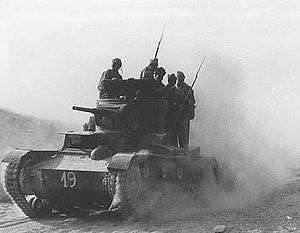
.svg.png)
